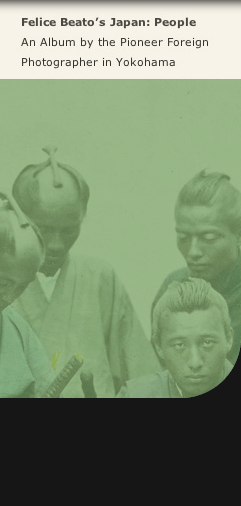
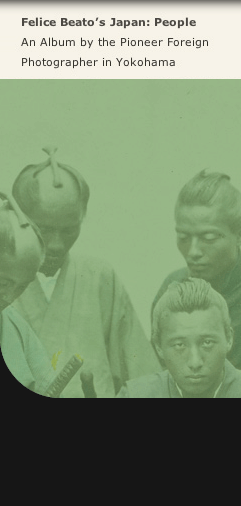
Album | Details
Scroll right to view all 50 images with captions transcribed verbatim from the ca. 1869 album.
Omissions due to length are indicated by an ellipsis.
Click here to go to the complete caption texts.
Scroll right to view all 50 images with captions transcribed verbatim from the ca. 1869 album.
Omissions due to length are indicated by an ellipsis.
Click here to go to the complete caption texts.
Beato album courtesy of Smith College Museum of Art
On viewing images from the historical record: click here
Massachusetts Institute of Technology © 2008 Visualizing Cultures
On viewing images from the historical record: click here
Massachusetts Institute of Technology © 2008 Visualizing Cultures
A YOUNG LADY COMING FROM THE BATH.
In the evening all the young ladies in Japan repair to the bath—every villiage is provided with this useful institution. It is the great meeting house or local parliament where the affairs of the nation are discussed. Female members are not excluded, and both sexes meet together on terms of perfect equality. The object of the bath is not cleanliness as much as a species of sensuality indulged in for the sake of the pleasurable feelings produced by the warm water; for the clothing is not always changed after performing the ablution. Private families not infrequently have a bath of their own; and the whole family may be seen in the summer time, enjoying this luxury in the open air or public street all paddling about, red as lobsters, in all the innocence of unfallen man.
In the evening all the young ladies in Japan repair to the bath—every villiage is provided with this useful institution. It is the great meeting house or local parliament where the affairs of the nation are discussed. Female members are not excluded, and both sexes meet together on terms of perfect equality. The object of the bath is not cleanliness as much as a species of sensuality indulged in for the sake of the pleasurable feelings produced by the warm water; for the clothing is not always changed after performing the ablution. Private families not infrequently have a bath of their own; and the whole family may be seen in the summer time, enjoying this luxury in the open air or public street all paddling about, red as lobsters, in all the innocence of unfallen man.
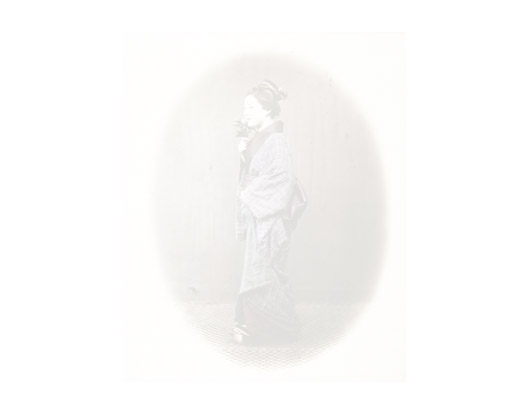
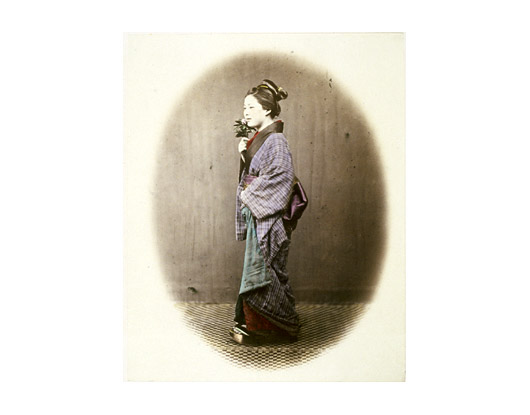
01
AMMA, —OR SHAMPOOER.
These men are blind, and may be recognized by their whistle, which is heard night and day. As a class they are favoured by the government, for the reason that about six hundred years ago the son of a Mikado became blind, and this induced the father, on account of his son’s afflictions, to confer certain privileges on all who suffered from blindness. The Ammas are permitted to lend money at extravagant rates of interest and enjoy many advantages in collecting their dues. Merchants and others who borrow money from them in cases of emergency, pay at the rate of nearly cent. Per cent. Per annum, and if the borrower is backward, or not punctual in returning the principal or interest, the Amma has only to complain to the government official, when immediate restitution is exacted. The interest asked by the Ammas is the highest in Japan, and they seldom lend for a longer period than a few days, or a few weeks at the utmost.
These men are blind, and may be recognized by their whistle, which is heard night and day. As a class they are favoured by the government, for the reason that about six hundred years ago the son of a Mikado became blind, and this induced the father, on account of his son’s afflictions, to confer certain privileges on all who suffered from blindness. The Ammas are permitted to lend money at extravagant rates of interest and enjoy many advantages in collecting their dues. Merchants and others who borrow money from them in cases of emergency, pay at the rate of nearly cent. Per cent. Per annum, and if the borrower is backward, or not punctual in returning the principal or interest, the Amma has only to complain to the government official, when immediate restitution is exacted. The interest asked by the Ammas is the highest in Japan, and they seldom lend for a longer period than a few days, or a few weeks at the utmost.
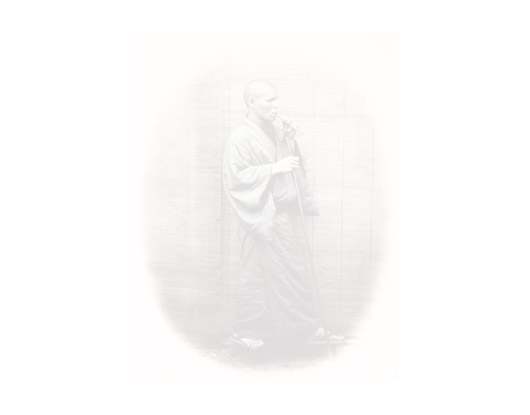
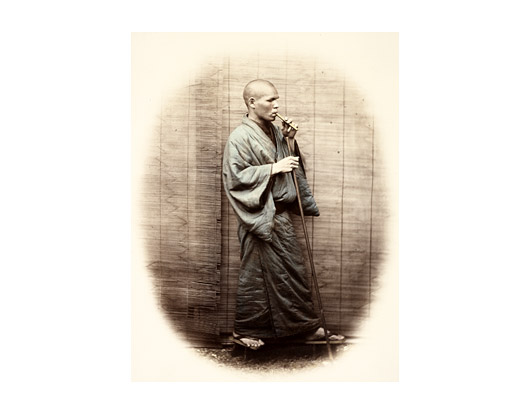
02
MODE OF SHAMPOOING.
SHAMPOOERS in Japan are almost always blind, and in great request. They seem also to be ever at hand when wanted; wandering as they do, night and day, notifying their whereabouts by blowing a double reed or bamboo whistle. Their services are called into requisition both by the sick and the robust: as their method of manipulating the muscles of the body produces a soothing sensation to the weary, and is a great relief to patients suffering from rheumatism: a very common ailment in the changeable climate of Japan.
The shampooers are a privileged class, and are frequently wealthy. From them the merchants and others borrow money in emergencies for short periods, at a very high rate of interest; and should they be slow in paying back what they have borrowed, complaint to the officials brings restitutions with interest, forthwith.
SHAMPOOERS in Japan are almost always blind, and in great request. They seem also to be ever at hand when wanted; wandering as they do, night and day, notifying their whereabouts by blowing a double reed or bamboo whistle. Their services are called into requisition both by the sick and the robust: as their method of manipulating the muscles of the body produces a soothing sensation to the weary, and is a great relief to patients suffering from rheumatism: a very common ailment in the changeable climate of Japan.
The shampooers are a privileged class, and are frequently wealthy. From them the merchants and others borrow money in emergencies for short periods, at a very high rate of interest; and should they be slow in paying back what they have borrowed, complaint to the officials brings restitutions with interest, forthwith.
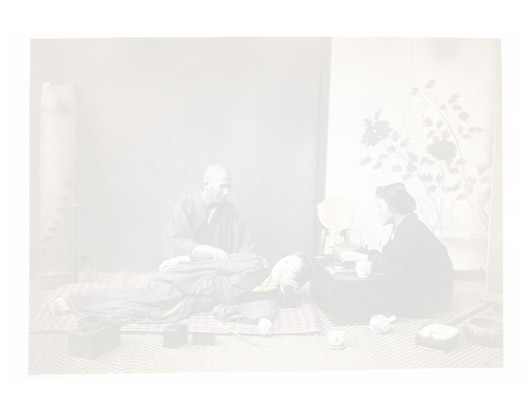
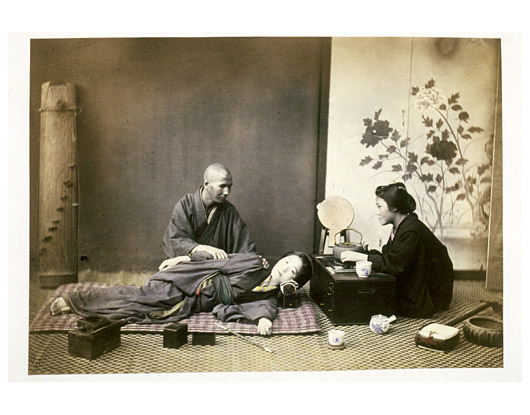
03
AT HER TOILET.
A young girl with two mirrors seeing whether her back hair is all right. Japanese women have their hair dressed by professional hairdressers every other day, or once in three days, as their means may admit. Sleeping as they do with their heads supported by a small wooden pillow with a padded cushion which just fits into the back of the neck, their night’s rest does not disturb their coiffure. Many are the ceremonies and intricate the mysteries of the Toilet. For all of these, explicit rules are laid down in the book called “Onna Dai-gaku,” or the complete Duty of woman—(literally “great learning” of woman.)
A young girl with two mirrors seeing whether her back hair is all right. Japanese women have their hair dressed by professional hairdressers every other day, or once in three days, as their means may admit. Sleeping as they do with their heads supported by a small wooden pillow with a padded cushion which just fits into the back of the neck, their night’s rest does not disturb their coiffure. Many are the ceremonies and intricate the mysteries of the Toilet. For all of these, explicit rules are laid down in the book called “Onna Dai-gaku,” or the complete Duty of woman—(literally “great learning” of woman.)
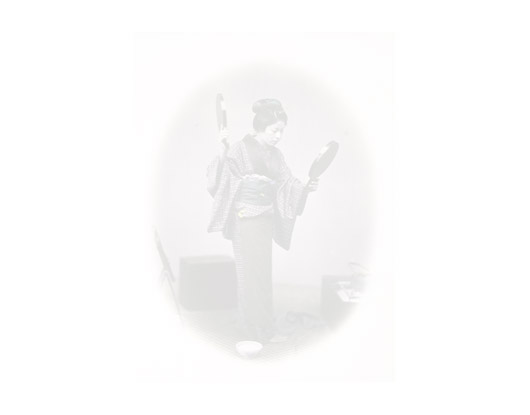
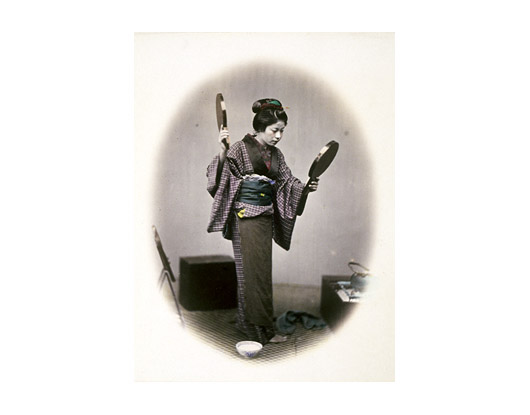
04
PUTTING ON THE OBI, OR GIRDLE.
This peculiar belt or girdle is universally worn by all classes of women in Japan with the exception of the female members of Daimio’s families; and the present style is said to have been in fashion about two hundred years. Little variation is ever made in the Obi, except perhaps in the breadth, which is rather greater now than was formerly worn. Nothing can be inferred respecting the position in society, from the manner of wearing it, although some have it tied in a large loose knot, and others with the cords hanging down the back, quite as fancy may suggest.
A woman who has become a widow and is determined so to remain for the rest of her life, ties her Obi in front. After death, (the female being dressed in her best apparel, exactly as in life), the Obi is tied, not in a bow, but strongly fastened in two knots, to indicate that it is never to be loosened.
This peculiar belt or girdle is universally worn by all classes of women in Japan with the exception of the female members of Daimio’s families; and the present style is said to have been in fashion about two hundred years. Little variation is ever made in the Obi, except perhaps in the breadth, which is rather greater now than was formerly worn. Nothing can be inferred respecting the position in society, from the manner of wearing it, although some have it tied in a large loose knot, and others with the cords hanging down the back, quite as fancy may suggest.
A woman who has become a widow and is determined so to remain for the rest of her life, ties her Obi in front. After death, (the female being dressed in her best apparel, exactly as in life), the Obi is tied, not in a bow, but strongly fastened in two knots, to indicate that it is never to be loosened.
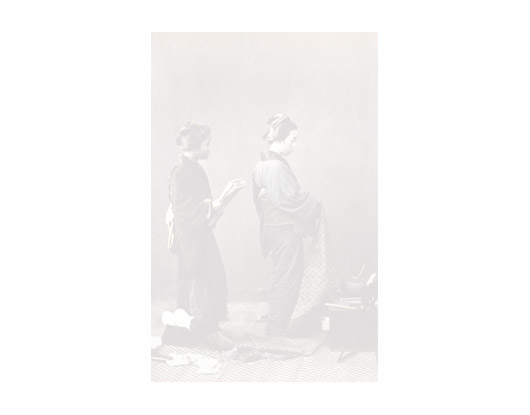
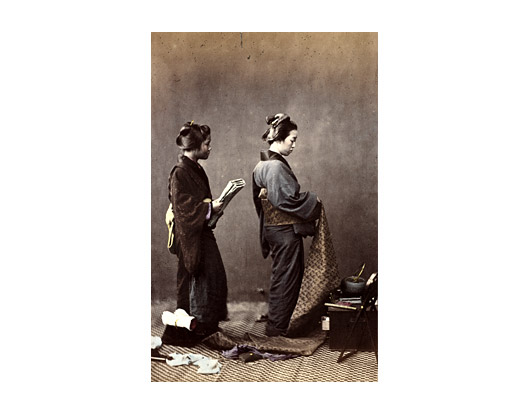
05
TWO LADIES WITH PARASOL.
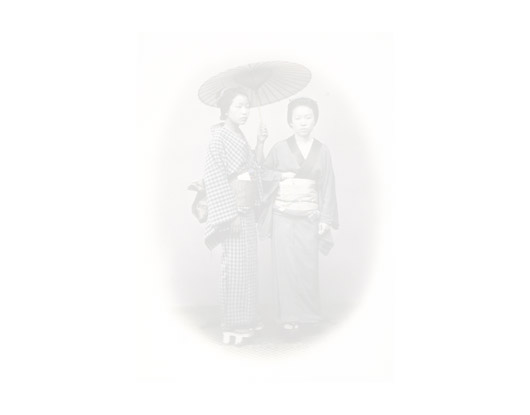
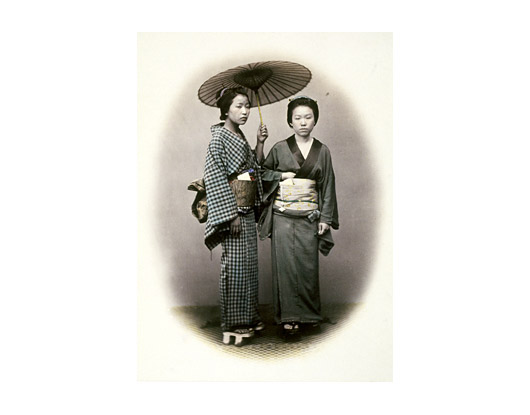
06
THE ORIGINAL “GRECIAN BEND.”
JAPAN, isolated though she has long been, has taught Europe a few things besides the mere art of “japanning” and the dwarfing of plants. On the occasion of the first embassy from the Tycoon being honourably received in Europe, several of the princes who were informed of it wrote to the Tycoon —“no doubt they (the foreign Courts), felt too much honoured in receiving Japanese, who, although not high born, are respectable persons, and who must have given a lesson in politeness and diplomacy to those nations who are not yet formed.” It would be surely very pleasing to those princes to see the adoption by the fashionable world of Paris, of the original “Grecian Bend,” copied from the Japanese moos’mies who waited on the visitors at the Tea house erected at the “Exposition Universelle” of 1867. Our artist has caught it exactly; and connoisseurs in the poetry of posture will easily trace the graceful wave named by Hogarth the “line of beauty.” The difference between the Japanese Moos’mie and her Parisian sister, is, that what the latter attains by much study and practice, the former grows into naturally, from politeness inculcated from the earliest childhood.
JAPAN, isolated though she has long been, has taught Europe a few things besides the mere art of “japanning” and the dwarfing of plants. On the occasion of the first embassy from the Tycoon being honourably received in Europe, several of the princes who were informed of it wrote to the Tycoon —“no doubt they (the foreign Courts), felt too much honoured in receiving Japanese, who, although not high born, are respectable persons, and who must have given a lesson in politeness and diplomacy to those nations who are not yet formed.” It would be surely very pleasing to those princes to see the adoption by the fashionable world of Paris, of the original “Grecian Bend,” copied from the Japanese moos’mies who waited on the visitors at the Tea house erected at the “Exposition Universelle” of 1867. Our artist has caught it exactly; and connoisseurs in the poetry of posture will easily trace the graceful wave named by Hogarth the “line of beauty.” The difference between the Japanese Moos’mie and her Parisian sister, is, that what the latter attains by much study and practice, the former grows into naturally, from politeness inculcated from the earliest childhood.
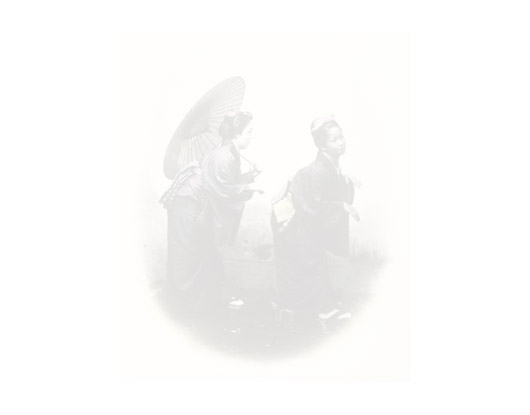
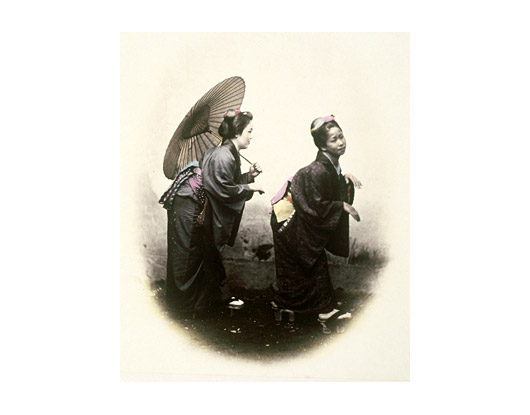
07
DANCING GIRL.
PRACTISING for this evening’s performance. This picture represents a very pretty dancing girl, not yet dressed out in her gorgeous attire, practicing the steps or rather the “poses” of a fashionable dance. The dancing girls like the singers are bought at an early age by managers who educate them to their profession, and maintain them until they are from 27 to 30 years of age, when their service expires and they are free. Young children sold for this profession at the age of five or six years, fetch from about 24 to 40 Bus.
PRACTISING for this evening’s performance. This picture represents a very pretty dancing girl, not yet dressed out in her gorgeous attire, practicing the steps or rather the “poses” of a fashionable dance. The dancing girls like the singers are bought at an early age by managers who educate them to their profession, and maintain them until they are from 27 to 30 years of age, when their service expires and they are free. Young children sold for this profession at the age of five or six years, fetch from about 24 to 40 Bus.
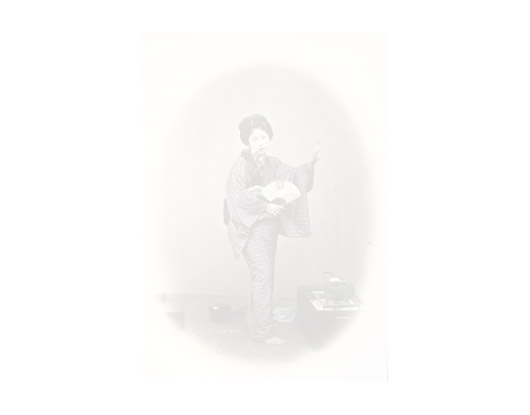
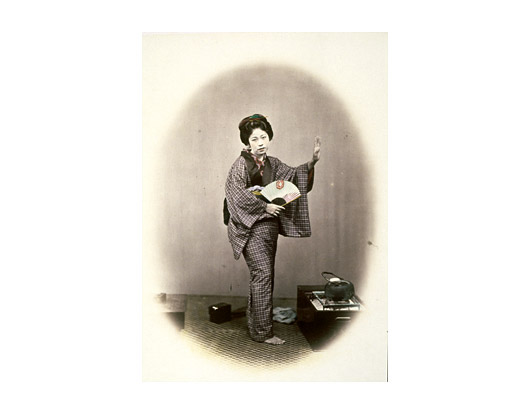
08
A SOCIAL MEAL.
THE humblest Japanese meal, although simple is served with a nicety and is accompanied by little luxurious delicacies, to which persons in the same class of life in what is termed civilized countries, are utter strangers.
The Rice which is the principal article of food, is always beautifully cooked, better than is ever seen anywhere but in eastern countries—and with it, various tasty condiments, such as pickles made with saki—soy—salted fish of sorts, and numerous other dainty little artfully manufactured appetizers are eaten. To moisten the meal, tea without sugar or milk is taken, and occasionally a small quantity of warm saki (which is a spirit distilled from Rice) and afterwards, a short whiff of the universally used pipe is inhaled by both sexes.
A Hibashi, or charcoal basin sometimes occupies the central position, round which the meal is enjoyed comfortably in cold weather, and on the fire of which the teapot is always kept cosily boiling.
THE humblest Japanese meal, although simple is served with a nicety and is accompanied by little luxurious delicacies, to which persons in the same class of life in what is termed civilized countries, are utter strangers.
The Rice which is the principal article of food, is always beautifully cooked, better than is ever seen anywhere but in eastern countries—and with it, various tasty condiments, such as pickles made with saki—soy—salted fish of sorts, and numerous other dainty little artfully manufactured appetizers are eaten. To moisten the meal, tea without sugar or milk is taken, and occasionally a small quantity of warm saki (which is a spirit distilled from Rice) and afterwards, a short whiff of the universally used pipe is inhaled by both sexes.
A Hibashi, or charcoal basin sometimes occupies the central position, round which the meal is enjoyed comfortably in cold weather, and on the fire of which the teapot is always kept cosily boiling.
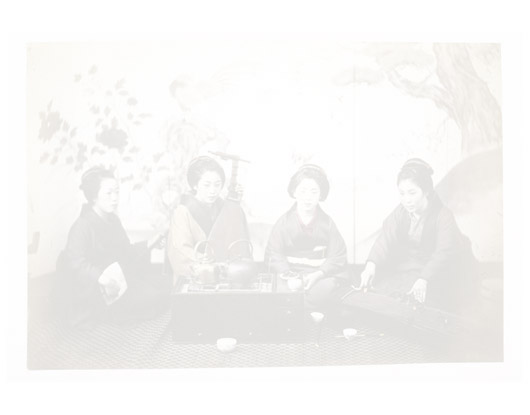
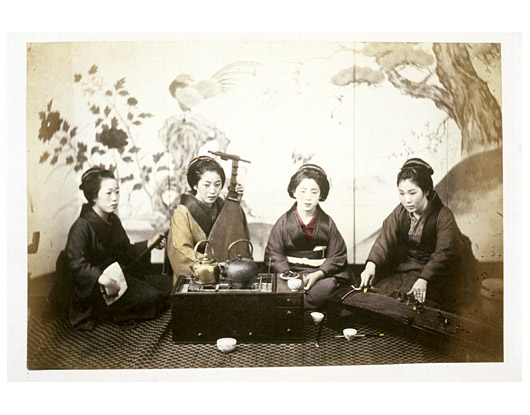
09
MOOS’MIE.
MOOS’MIE is the Japanese word for a female from birth to marriage,—equivalent to our word ’girl.’ The lassie depicted here, belongs to a rank of life corresponding with our domestics; but she is in her clean walking attire. The condition of a moos’mie of this class, presuming her to be of respectable parents who are not in straitened circumstances, is by no means a hard one. She is taught to read and write; as well as to play the samisen and sing, if her taste lies in that direction. And as the houses of the commonalty are always more or less open, and they may be said to live in public, a freedom and openness is engendered, that seems to set every scandalous thought at defiance. When the time comes for her marriage, her parents make the needful arrangements in her behalf, with the parents of the swain who desires or is willing to take her as a wife; and a favourable day having been named by the priests or diviners, whichever are appealed to, the happy couple are united with no further ceremony, than the acceptance of each other in a general assemblage of their friends, who make them such presents as they can afford, and then feast and drink saki to their hearts’ content.
MOOS’MIE is the Japanese word for a female from birth to marriage,—equivalent to our word ’girl.’ The lassie depicted here, belongs to a rank of life corresponding with our domestics; but she is in her clean walking attire. The condition of a moos’mie of this class, presuming her to be of respectable parents who are not in straitened circumstances, is by no means a hard one. She is taught to read and write; as well as to play the samisen and sing, if her taste lies in that direction. And as the houses of the commonalty are always more or less open, and they may be said to live in public, a freedom and openness is engendered, that seems to set every scandalous thought at defiance. When the time comes for her marriage, her parents make the needful arrangements in her behalf, with the parents of the swain who desires or is willing to take her as a wife; and a favourable day having been named by the priests or diviners, whichever are appealed to, the happy couple are united with no further ceremony, than the acceptance of each other in a general assemblage of their friends, who make them such presents as they can afford, and then feast and drink saki to their hearts’ content.
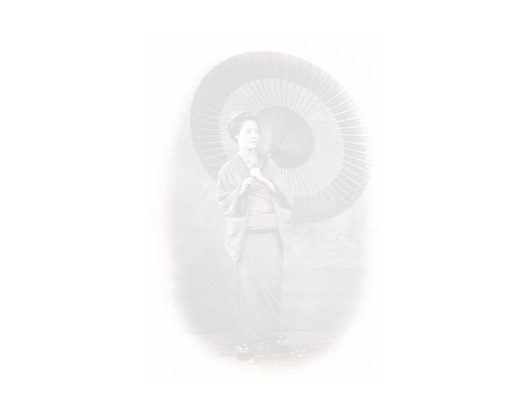
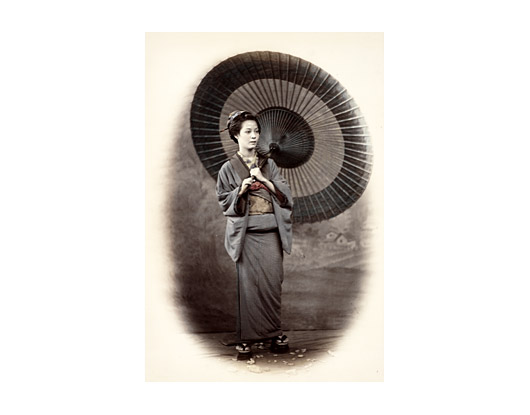
10
JAPANESE OFFICER’S WIFE.
IT is the custom among civilized nations to regard the piercing of the nose as an unmistakable evidence of barbarism; although their own fashions countenance and require the boring of the ears, and ear-rings to be worn. The Japanese do not indulge in either of these habits. They have however, a custom far more barbarous then either nose or ear piercing, and which makes their women perfectly hideous. Directly a woman is married the law compels her to stain her teeth black, and to shave or pluck out her eyebrows; To imagine anything more repulsive looking than a mouth like an “open sepulcher,” or face, otherwise passably pretty, disfigured by a grinning row of lacquered teeth, and innocent of eyebrows is impossible. The materials used for blackening the teeth are also so destructive, that in a very short time after marriage, few are left, the health suffers, and to this cause, in addition to the immoderate and universal use of warm baths, may in great measure be ascribed the premature look of age generally remarked among married women, who, at twenty five look at least ten years older.
IT is the custom among civilized nations to regard the piercing of the nose as an unmistakable evidence of barbarism; although their own fashions countenance and require the boring of the ears, and ear-rings to be worn. The Japanese do not indulge in either of these habits. They have however, a custom far more barbarous then either nose or ear piercing, and which makes their women perfectly hideous. Directly a woman is married the law compels her to stain her teeth black, and to shave or pluck out her eyebrows; To imagine anything more repulsive looking than a mouth like an “open sepulcher,” or face, otherwise passably pretty, disfigured by a grinning row of lacquered teeth, and innocent of eyebrows is impossible. The materials used for blackening the teeth are also so destructive, that in a very short time after marriage, few are left, the health suffers, and to this cause, in addition to the immoderate and universal use of warm baths, may in great measure be ascribed the premature look of age generally remarked among married women, who, at twenty five look at least ten years older.
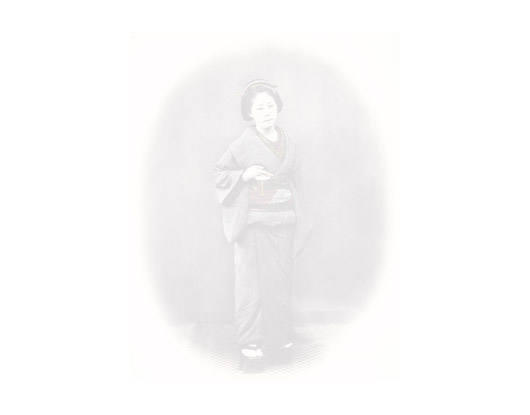
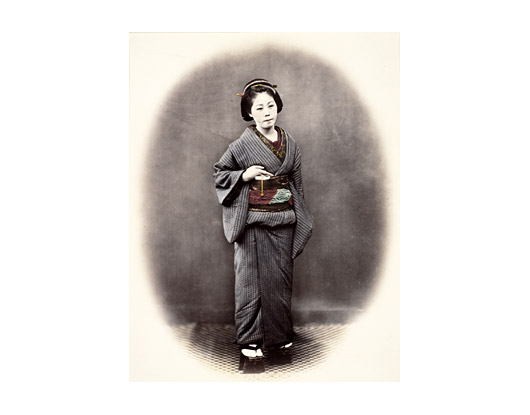
11
MOTHER AND CHILD.
SIR Rutherford Alcock calls Japan a very paradise of babies! Once a year, about May, there is a grand tete called a Matsz-ri, held in honour of all the male children; on which occasion large paper fish are hoisted on a pole or bamboo, over every house where a son has been born during the past twelve months. There is a similar Matz-ri also for girls, but later in the year. Until children are able to walk they are carried on the back in the manner shown in the accompanying picture; either by the mother, or, sometimes, by a brother or sister very little older than the infant. Parents have the power of selling their children, and frequently do so, especially those of the female sex. One fact may be noted respecting the treatment of children, viz.,—that they are seldom or never harshly used, or chastised, or even rebuked; but they seem always to be happy, and on terms of easy confidence with their elders, although taught to be respectful to them. There is wonderful patience shown by parents in quieting young children and both patience and care displayed in their early education.
SIR Rutherford Alcock calls Japan a very paradise of babies! Once a year, about May, there is a grand tete called a Matsz-ri, held in honour of all the male children; on which occasion large paper fish are hoisted on a pole or bamboo, over every house where a son has been born during the past twelve months. There is a similar Matz-ri also for girls, but later in the year. Until children are able to walk they are carried on the back in the manner shown in the accompanying picture; either by the mother, or, sometimes, by a brother or sister very little older than the infant. Parents have the power of selling their children, and frequently do so, especially those of the female sex. One fact may be noted respecting the treatment of children, viz.,—that they are seldom or never harshly used, or chastised, or even rebuked; but they seem always to be happy, and on terms of easy confidence with their elders, although taught to be respectful to them. There is wonderful patience shown by parents in quieting young children and both patience and care displayed in their early education.
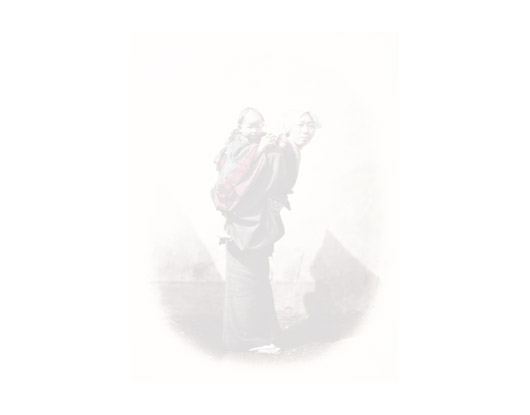
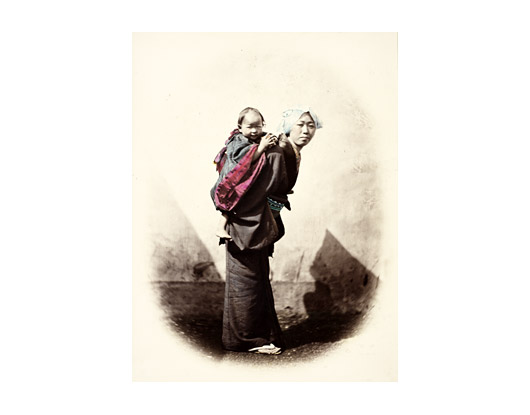
12
”THE BELLE OF THE PERIOD.”
Fashion is no less a tyrant in Japan than in Western Countries—and the numerous particulars which have to be attended to by the “Belle of the period” in the matter of the pattern and style of the dress, the mode of putting up the hair, the selection of colours, &c., are more than one uninitiated into these mysteries can pretend to describe. It is in the “obi” or girdle, however, that all this culminates; and to be out of the fashion in the matter of the pattern of the “obi” is more than the nature of the “Belle of the period” can tolerate. The present mode (1869) requires that the “obi” should be of a pattern spangled with chrysanthemum flowers,—like the chrysanthemum of the Mikado’s crest.
The change of mode is very serious matter for the pocket of the unhappy individual who is taxed to provide these articles for any “Belle of the period.” This fact will be obvious enough when it is stated that one of these “obis” of the present pattern costs no less a sum than thirty and half dollars.
Fashion is no less a tyrant in Japan than in Western Countries—and the numerous particulars which have to be attended to by the “Belle of the period” in the matter of the pattern and style of the dress, the mode of putting up the hair, the selection of colours, &c., are more than one uninitiated into these mysteries can pretend to describe. It is in the “obi” or girdle, however, that all this culminates; and to be out of the fashion in the matter of the pattern of the “obi” is more than the nature of the “Belle of the period” can tolerate. The present mode (1869) requires that the “obi” should be of a pattern spangled with chrysanthemum flowers,—like the chrysanthemum of the Mikado’s crest.
The change of mode is very serious matter for the pocket of the unhappy individual who is taxed to provide these articles for any “Belle of the period.” This fact will be obvious enough when it is stated that one of these “obis” of the present pattern costs no less a sum than thirty and half dollars.
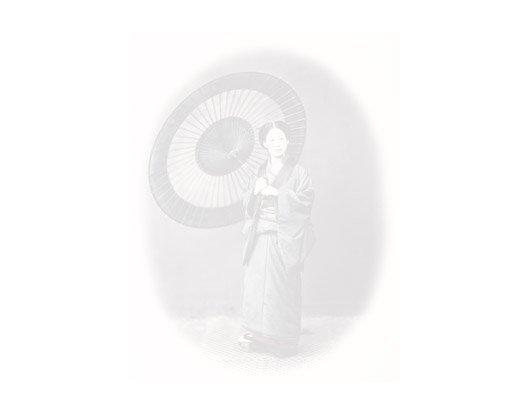
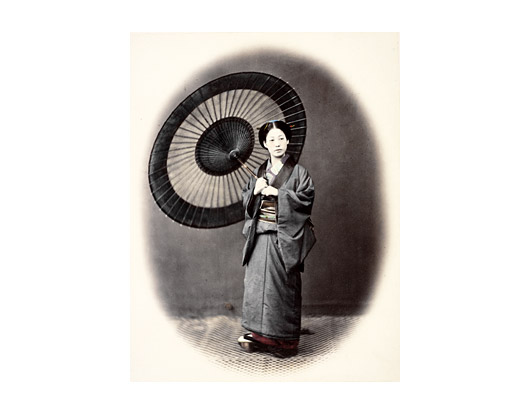
13
YOUNG LADY, WITH PIPE.
FOR the use, cultivation, and name of tobacco, the Japanese are indebted to the Portuguese. Its consumption is universal, both by men and women; the quantity used in their tiny pipes is very small, a single whiff only —which is inhaled, swallowed, and allowed to escape through the nostrils—being taken at one time.
A neatly ornamented box called hibachi, containing a small quantity of lighted charcoal in the metal brazier, tobacco in the drawers, toothpicks, pins, and also a spitting pot is always brought to a visitor, who is pressed to smoke by his host or hostess. Tea and often sweetmeats are presented at the same time.
In official calls, or audiences with persons in authority, no business is discussed before the exchange of various compliments, and the partaking of tobacco and tea.
FOR the use, cultivation, and name of tobacco, the Japanese are indebted to the Portuguese. Its consumption is universal, both by men and women; the quantity used in their tiny pipes is very small, a single whiff only —which is inhaled, swallowed, and allowed to escape through the nostrils—being taken at one time.
A neatly ornamented box called hibachi, containing a small quantity of lighted charcoal in the metal brazier, tobacco in the drawers, toothpicks, pins, and also a spitting pot is always brought to a visitor, who is pressed to smoke by his host or hostess. Tea and often sweetmeats are presented at the same time.
In official calls, or audiences with persons in authority, no business is discussed before the exchange of various compliments, and the partaking of tobacco and tea.
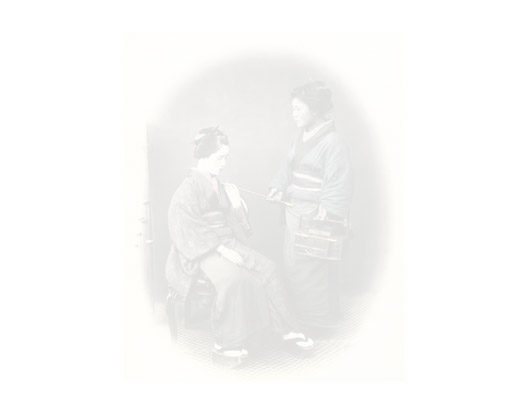
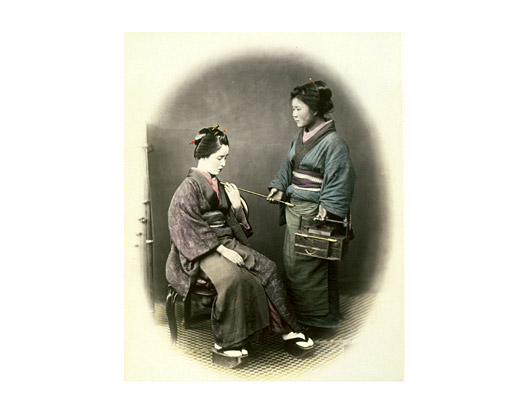
14
GIRL PLAYING THE KOTO.
JAPANESE girls do not appear to have many resources on which they can depend for the occupation of spare hours. The knitting, crochet, worsted work, tatting, and other feminine accomplishments of civilized society seem to be unknown. Whenever resort is had to the Koto, or musical instrument here shown, the style of melody, if such it can be called, is not of a kind to elicit either admiration, approval, or even tolerance from the foreign ear.
There is a written instruction for their music, although merely a series of directions for raising or lowering the voice, which in their dramas may be better described as marginal notes; but they have no distinct character. Good proof of this is that their professors and teachers are frequently blind; so that the assumption that most of their airs are legendary refrains, handed down from one generation to another, and acquired by ear, is not without foundation.
JAPANESE girls do not appear to have many resources on which they can depend for the occupation of spare hours. The knitting, crochet, worsted work, tatting, and other feminine accomplishments of civilized society seem to be unknown. Whenever resort is had to the Koto, or musical instrument here shown, the style of melody, if such it can be called, is not of a kind to elicit either admiration, approval, or even tolerance from the foreign ear.
There is a written instruction for their music, although merely a series of directions for raising or lowering the voice, which in their dramas may be better described as marginal notes; but they have no distinct character. Good proof of this is that their professors and teachers are frequently blind; so that the assumption that most of their airs are legendary refrains, handed down from one generation to another, and acquired by ear, is not without foundation.
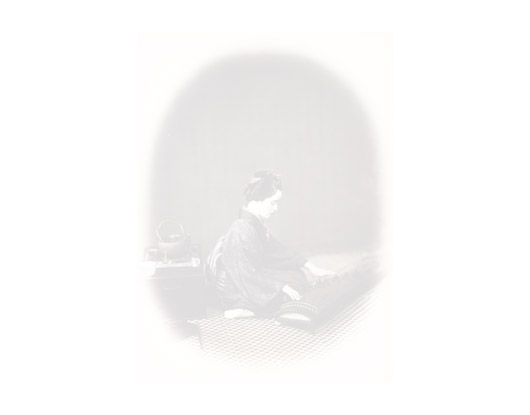
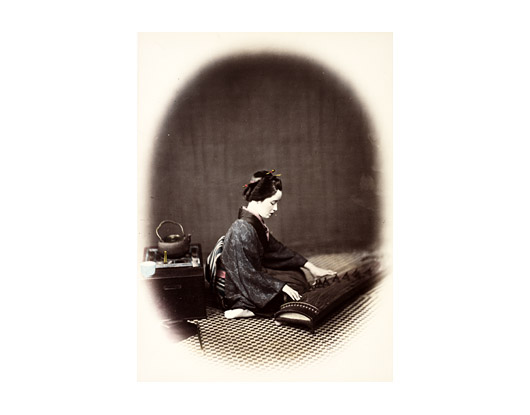
15
GIRL PLAYING THE SAMISEN.
THE Japanese guitar or “samisen” is a very simple instrument—a small box of wood covered with parchment, and with only three strings. It is generally played with a flat piece of wood, or ivory, or horn, and is seldom struck with the fingers.
The music does not strike one as being harmonious, but wild and harsh. The airs are occasionally plaintive, but the voice in singing is never natural, and seems to be an acquired sort of falsetto, which is by no means pleasant to the ear.
Music is part of the education of most girls of any pretentions; and to its acquirement a great deal of time and labour are devoted—yet there is a wonderful absence of any approach to harmony in the airs played by even the most carefully taught.
THE Japanese guitar or “samisen” is a very simple instrument—a small box of wood covered with parchment, and with only three strings. It is generally played with a flat piece of wood, or ivory, or horn, and is seldom struck with the fingers.
The music does not strike one as being harmonious, but wild and harsh. The airs are occasionally plaintive, but the voice in singing is never natural, and seems to be an acquired sort of falsetto, which is by no means pleasant to the ear.
Music is part of the education of most girls of any pretentions; and to its acquirement a great deal of time and labour are devoted—yet there is a wonderful absence of any approach to harmony in the airs played by even the most carefully taught.
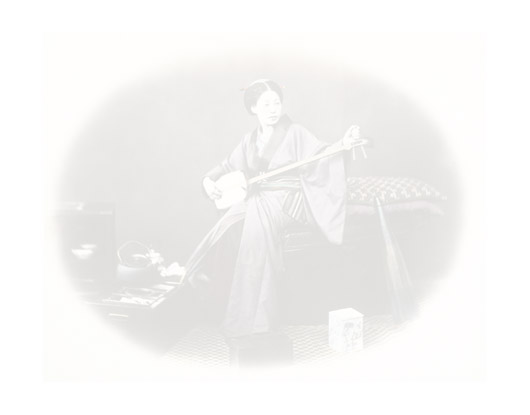
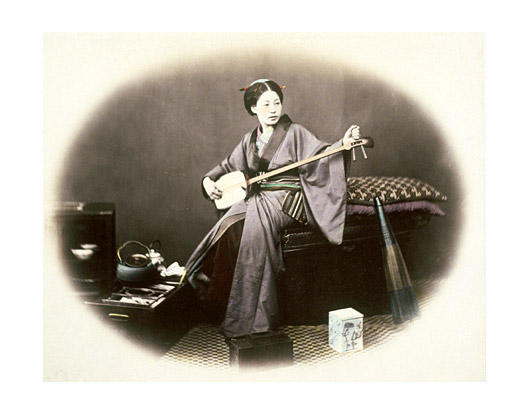
16
A SOCIAL MEAL.
THE humblest Japanese meal, although simple is served with a nicety and is accompanied by little luxurious delicacies, to which persons in the same class of life in what is termed civilized countries, are utter strangers.
The Rice which is the principal article of food, is always beautifully cooked, better than is ever seen anywhere but in eastern countries—and with it, various tasty condiments, such as pickles made with saki—soy—salted fish of sorts, and numerous other dainty little artfully manufactured appetizers are eaten. To moisten the meal, tea without sugar or milk is taken, and occasionally a small quantity of warm saki (which is a spirit distilled from Rice) and afterwards, a short whiff of the universally used pipe is inhaled by both sexes.
A Hibashi, or charcoal basin sometimes occupies the central position, round which the meal is enjoyed comfortably in cold weather, and on the fire of which the teapot is always kept cosily boiling.
THE humblest Japanese meal, although simple is served with a nicety and is accompanied by little luxurious delicacies, to which persons in the same class of life in what is termed civilized countries, are utter strangers.
The Rice which is the principal article of food, is always beautifully cooked, better than is ever seen anywhere but in eastern countries—and with it, various tasty condiments, such as pickles made with saki—soy—salted fish of sorts, and numerous other dainty little artfully manufactured appetizers are eaten. To moisten the meal, tea without sugar or milk is taken, and occasionally a small quantity of warm saki (which is a spirit distilled from Rice) and afterwards, a short whiff of the universally used pipe is inhaled by both sexes.
A Hibashi, or charcoal basin sometimes occupies the central position, round which the meal is enjoyed comfortably in cold weather, and on the fire of which the teapot is always kept cosily boiling.
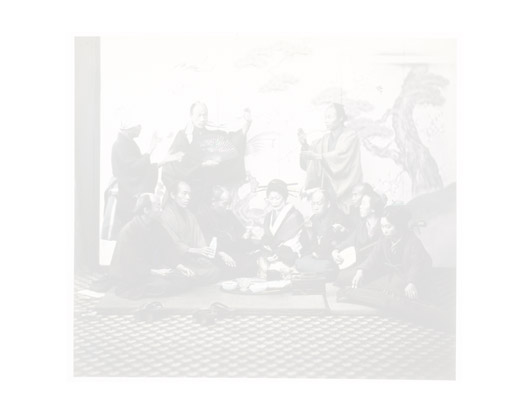
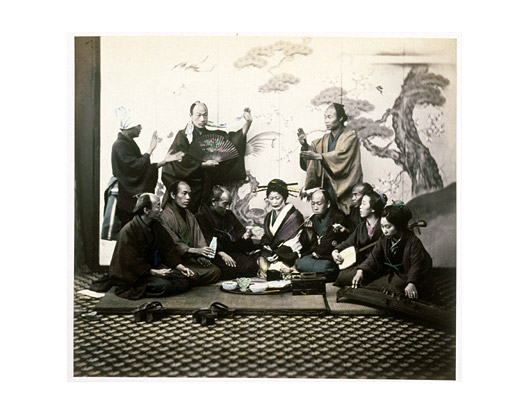
17
SLEEPING BEAUTIES.
THE pillows used by the Japanese are hollow wooden boxes—oblong—about four or five inches high, and sometimes curved at the broader part, which is the bottom. They are used as toilet boxes in which to keep combs, and other little toilet requisites. On the top, on which the neck rests, there is a roll of paper, and a clean pillow case is quickly provided, by either removing the upper sheet or putting on an extra slip of the same material.
A large quilt, made of cotton cloth, (or perhaps of silk), with cotton between to afford warmth, forms the covering, and the same sort of thing does for mattress. Bedsteads are unknown.
The Japanese seldom sleep without a night light—a simple earthenware saucer of oil, with a pith or wax-covered wick lying therein, kept down by a small iron weight. This is enclosed in a paper-covered frame, as seen in the picture; and gives a soft subdued light.
THE pillows used by the Japanese are hollow wooden boxes—oblong—about four or five inches high, and sometimes curved at the broader part, which is the bottom. They are used as toilet boxes in which to keep combs, and other little toilet requisites. On the top, on which the neck rests, there is a roll of paper, and a clean pillow case is quickly provided, by either removing the upper sheet or putting on an extra slip of the same material.
A large quilt, made of cotton cloth, (or perhaps of silk), with cotton between to afford warmth, forms the covering, and the same sort of thing does for mattress. Bedsteads are unknown.
The Japanese seldom sleep without a night light—a simple earthenware saucer of oil, with a pith or wax-covered wick lying therein, kept down by a small iron weight. This is enclosed in a paper-covered frame, as seen in the picture; and gives a soft subdued light.
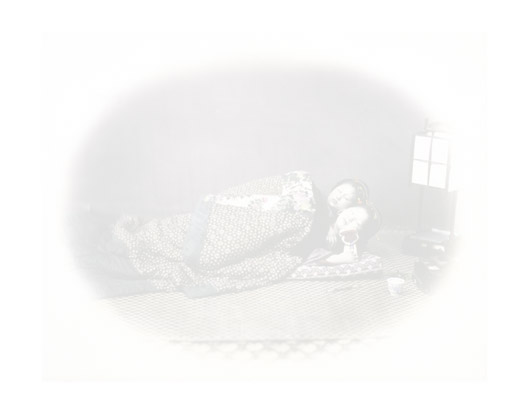
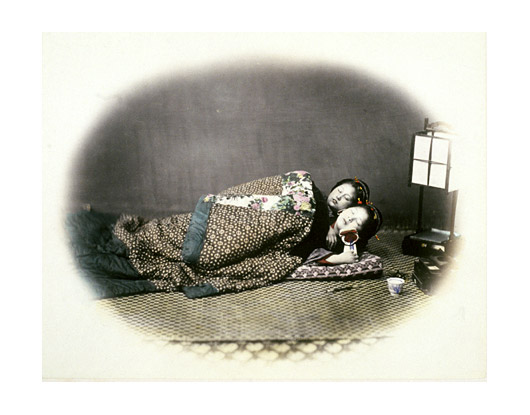
18
JAPANESE DOCTOR AND PATIENT.
AS Physicians, the Japanese are very backward in knowledge of the healing art. Although they make formidable display of medicines, wich are done up and labeled with imposing care. The prescriptions are simple preparations from herbs and roots. Their knowledge of material medica has been acquired from translations, in the first instance, of Chinese works; and, more recently, from medical works introduced by the Dutch from Europe. They do not seem to have any regular Academical or Professional education as preparation for the medical faculty, but in most instances a son succeeds his father in his practice, or a doctor instructs a few pupils. As Surgeons they are even more backward than as Physicians, they are unable to perform the most simple operation, and the amputation of a limb is far beyond their comprehension.
Doctors are privileged to wear two swords, and the simple fact of their practicing the healing art seems to entitle them to this distinction, without the possession of any diploma.
AS Physicians, the Japanese are very backward in knowledge of the healing art. Although they make formidable display of medicines, wich are done up and labeled with imposing care. The prescriptions are simple preparations from herbs and roots. Their knowledge of material medica has been acquired from translations, in the first instance, of Chinese works; and, more recently, from medical works introduced by the Dutch from Europe. They do not seem to have any regular Academical or Professional education as preparation for the medical faculty, but in most instances a son succeeds his father in his practice, or a doctor instructs a few pupils. As Surgeons they are even more backward than as Physicians, they are unable to perform the most simple operation, and the amputation of a limb is far beyond their comprehension.
Doctors are privileged to wear two swords, and the simple fact of their practicing the healing art seems to entitle them to this distinction, without the possession of any diploma.
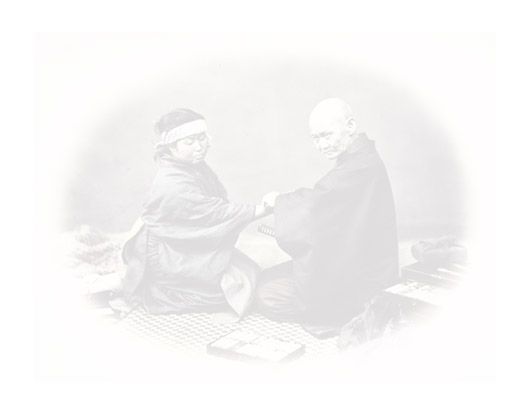
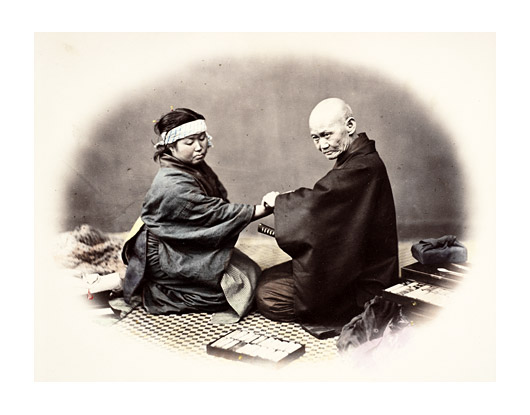
19
"GO".
A PECULIARITY among the Japanese is that they appear to have a prodigious amount of time on their hands. With us, tradesmen who have but little to do, like to look as if they had much; and any of them caught playing a game at cards or backgammon in the middle of the day, would be likely to have the fate of “the idle apprentice” prognosticated for them. But it is otherwise in Japan. All the shops are open, and the shopkeepers sit on their heels on their mats, exposed to the view of every passer-by. It would be impossible to go through the native town of Yokohama any day, at any time, without seeing such a scene as is depicted in the accompanying photograph, in many of the shops. It is a game rejoicing in the emphatic-sounding name of “Go.” It is a rude kind of chess, but we have never seen any foreigner who has troubled himself to master it. In the merchant’s warehouses, the clerks or bantos, and in the retail shops the shopmen, fly to it to kill time whenever business flags; and any foreigner would come to the conclusion, from the numbers he sees playing at “go,” that everything like “occupation” had absolutely “gone.”
A PECULIARITY among the Japanese is that they appear to have a prodigious amount of time on their hands. With us, tradesmen who have but little to do, like to look as if they had much; and any of them caught playing a game at cards or backgammon in the middle of the day, would be likely to have the fate of “the idle apprentice” prognosticated for them. But it is otherwise in Japan. All the shops are open, and the shopkeepers sit on their heels on their mats, exposed to the view of every passer-by. It would be impossible to go through the native town of Yokohama any day, at any time, without seeing such a scene as is depicted in the accompanying photograph, in many of the shops. It is a game rejoicing in the emphatic-sounding name of “Go.” It is a rude kind of chess, but we have never seen any foreigner who has troubled himself to master it. In the merchant’s warehouses, the clerks or bantos, and in the retail shops the shopmen, fly to it to kill time whenever business flags; and any foreigner would come to the conclusion, from the numbers he sees playing at “go,” that everything like “occupation” had absolutely “gone.”
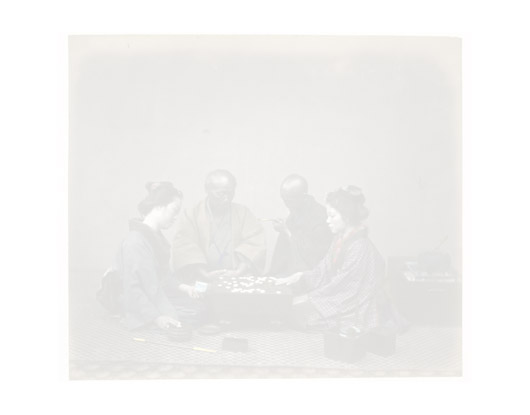
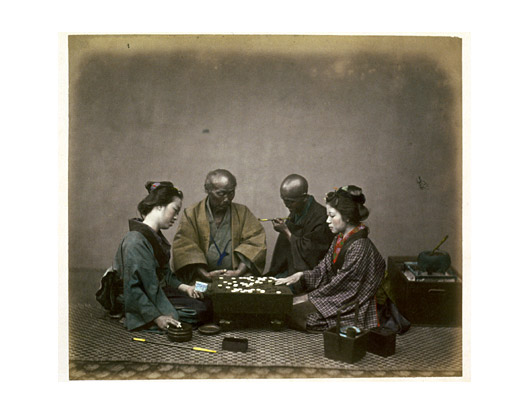
20
MENDICANT NUN.
ACCORDING to Kempfer, these nuns live under the protection of the nunneries at Kamakura and Kioto; and pay to them a certain sum every year of what they get by begging, as an acknowledgment of their authority. In his opinion they were much the handsomest girls he saw in Japan.
The daughters of poor peasants, if they be handsome and agreeable, apply for and easily obtain the privilege of begging in the habit of nuns, knowing that beauty is one of the most persuasive inducements to generosity.
The begging mountain priests frequently incorporate their own daughters with this religious order, and take their wives from among them.
Mendicant nuns usually wear a large hat made of straw or plaited bamboo to cover their faces and to shelter them also from the heat of the sun.
ACCORDING to Kempfer, these nuns live under the protection of the nunneries at Kamakura and Kioto; and pay to them a certain sum every year of what they get by begging, as an acknowledgment of their authority. In his opinion they were much the handsomest girls he saw in Japan.
The daughters of poor peasants, if they be handsome and agreeable, apply for and easily obtain the privilege of begging in the habit of nuns, knowing that beauty is one of the most persuasive inducements to generosity.
The begging mountain priests frequently incorporate their own daughters with this religious order, and take their wives from among them.
Mendicant nuns usually wear a large hat made of straw or plaited bamboo to cover their faces and to shelter them also from the heat of the sun.
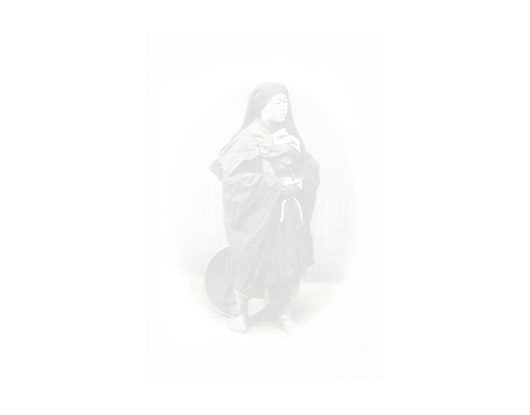
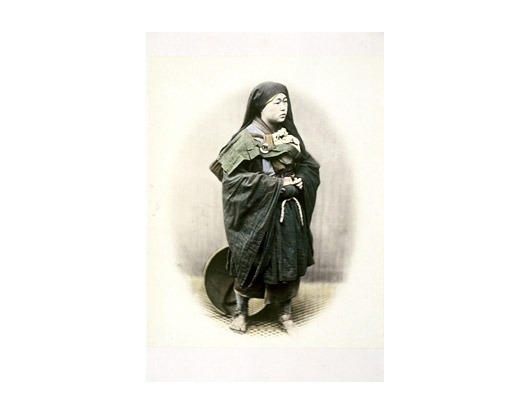
21
STREET REFRESHMENT STALLS.
AT any corner where there is an extensive thoroughfare, a stand of this description may be seen; it is called Ya-tai-mise, or “Field table stand. Coolies generally supply themselves with their meals from these stalls, and there are always attractive-looking sweets wherewith to tempt children. A small charcoal fire assists in the culinary preparations, (which are of a simple sort), and keeps the teapot boiling and ready for immediate use.
The transparency over the stall-keeper’s head protects a lamp at night, and is usually ornamented with some fancy sketch, or with the name and calling of the owner, in bright colours. No respectable Japanese ever thinks of obtaining refreshment from a street vendor, whose principal customers are therefore from the lower classes.
AT any corner where there is an extensive thoroughfare, a stand of this description may be seen; it is called Ya-tai-mise, or “Field table stand. Coolies generally supply themselves with their meals from these stalls, and there are always attractive-looking sweets wherewith to tempt children. A small charcoal fire assists in the culinary preparations, (which are of a simple sort), and keeps the teapot boiling and ready for immediate use.
The transparency over the stall-keeper’s head protects a lamp at night, and is usually ornamented with some fancy sketch, or with the name and calling of the owner, in bright colours. No respectable Japanese ever thinks of obtaining refreshment from a street vendor, whose principal customers are therefore from the lower classes.
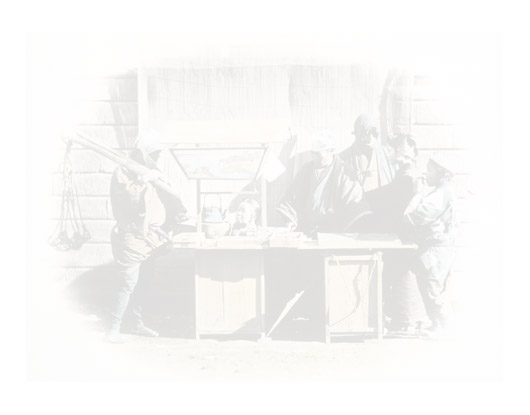
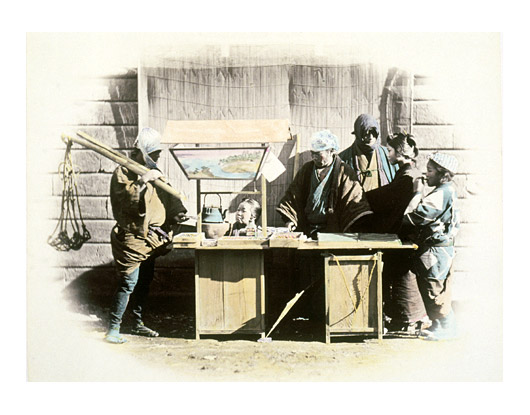
22
SAKI SELLER.
OF beverages ordinarily consumed by the Japanese, there may be said to be but two—Tea and Saki.
The latter is distilled from Rice; and it is of almost any degree of strength, from weak wine to strong spirits. That sold by the itinerant vendor, is a sort of sweet beer, not very intoxicating, mixed with mild, and even, sometimes, a little salt.
The practice of saki drinking is not confined to the male sex. Women partake of it freely, but seldom to excess. Men, however, especially the idlers among the followers and retainers of Daimios, indulge much too freely in saki; indeed, there are parts of the road to Yedo, particularly the suburb of Sinagawa, which are rendered quite unsafe after dark, by this two-sworded class who may be met, with flushed faces and glazed eye, reeling under the influence of copious draughts of this intoxicating liquor; and when in this state, they are quarrelsome and dangerous.
OF beverages ordinarily consumed by the Japanese, there may be said to be but two—Tea and Saki.
The latter is distilled from Rice; and it is of almost any degree of strength, from weak wine to strong spirits. That sold by the itinerant vendor, is a sort of sweet beer, not very intoxicating, mixed with mild, and even, sometimes, a little salt.
The practice of saki drinking is not confined to the male sex. Women partake of it freely, but seldom to excess. Men, however, especially the idlers among the followers and retainers of Daimios, indulge much too freely in saki; indeed, there are parts of the road to Yedo, particularly the suburb of Sinagawa, which are rendered quite unsafe after dark, by this two-sworded class who may be met, with flushed faces and glazed eye, reeling under the influence of copious draughts of this intoxicating liquor; and when in this state, they are quarrelsome and dangerous.

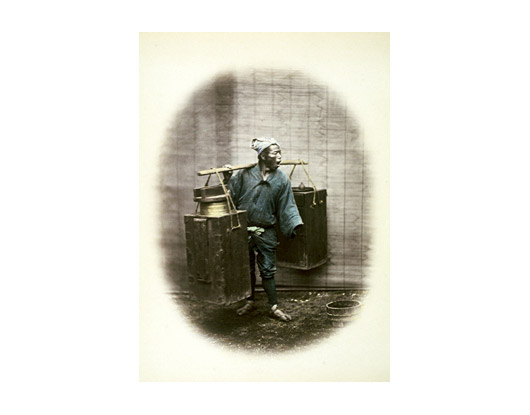
23
STREET MUSICIANS.
LIKE the organ-grinders in Europe, the street musicians of Japan are more frequently paid to discontinue their strains than otherwise; for the music discoursed by them is not of the sweetest description.
The wives and daughters of Yetas are sometimes street minstrels. Yetas are tanners—a class that holds the lowest position in the scale of society—said to be the descendants of Corean prisoners. From this class are taken the public executioners; who, although held in universal execration, are yet allowed to wear two swords. Tanners are compelled to reside in villages by themselves; and it is an extraordinary fact, that in measuring distances, the part of a road which passes through one of their villages, is not reckoned in the measurement; so that kango bearers and coolies are really obliged to carry their burdens that far gratis. The Yetas may not enter a house, or site, or cook at the same fire, or use any of the same utensils, with persons not belonging to their own class.
LIKE the organ-grinders in Europe, the street musicians of Japan are more frequently paid to discontinue their strains than otherwise; for the music discoursed by them is not of the sweetest description.
The wives and daughters of Yetas are sometimes street minstrels. Yetas are tanners—a class that holds the lowest position in the scale of society—said to be the descendants of Corean prisoners. From this class are taken the public executioners; who, although held in universal execration, are yet allowed to wear two swords. Tanners are compelled to reside in villages by themselves; and it is an extraordinary fact, that in measuring distances, the part of a road which passes through one of their villages, is not reckoned in the measurement; so that kango bearers and coolies are really obliged to carry their burdens that far gratis. The Yetas may not enter a house, or site, or cook at the same fire, or use any of the same utensils, with persons not belonging to their own class.
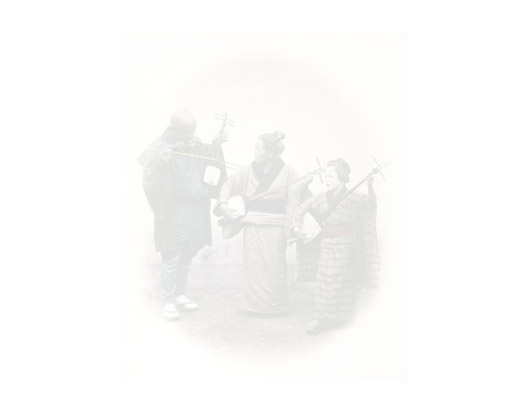
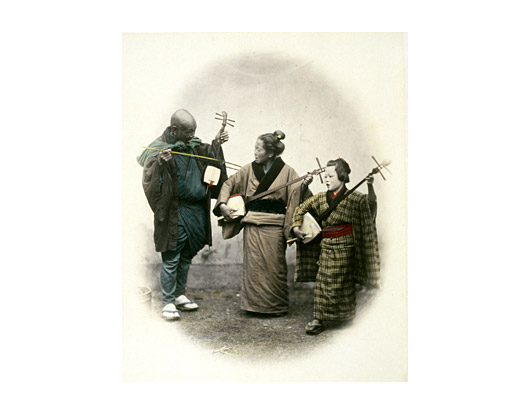
24
PRIESTS OR ZEN SHU.
THESE Priests are of the Nitchi-ren-shu sect, an order of about six hundred years standing. Their beads, which are one hundred and eight in number, are supposed to correspond with the catalogue of mortal sins, which must be atoned for by prayer, &c. They are maintained by contributions which are voluntary; by the endowments of their temples, grounds and lands; they also collect sums of money under pretence of building new temples; and although they frequently appropriate the sums so collected to their own use, lending them out at interest, and live on the interest thus derived, there does not seem to be any public scandal attached to this proceeding.
The rate of interest exacted by the priesthood is the lowest in Japan, and perhaps this may in some degree excuse their misapplying funds intended for other purposes.
THESE Priests are of the Nitchi-ren-shu sect, an order of about six hundred years standing. Their beads, which are one hundred and eight in number, are supposed to correspond with the catalogue of mortal sins, which must be atoned for by prayer, &c. They are maintained by contributions which are voluntary; by the endowments of their temples, grounds and lands; they also collect sums of money under pretence of building new temples; and although they frequently appropriate the sums so collected to their own use, lending them out at interest, and live on the interest thus derived, there does not seem to be any public scandal attached to this proceeding.
The rate of interest exacted by the priesthood is the lowest in Japan, and perhaps this may in some degree excuse their misapplying funds intended for other purposes.
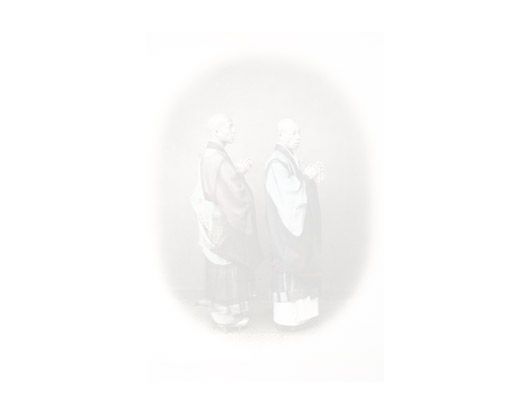
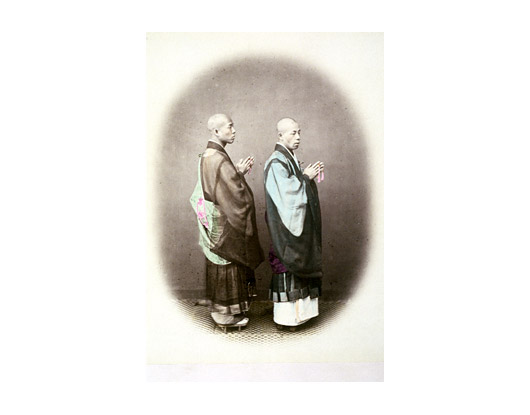
25
COOLIE OF THE SCAVENGER CORPS.
VISITORS to Japan, find a never-ceasing theme of admiration in its rich-looking soil, and the excellent and careful method with which it is cultivated. From the beautiful appearance of the crops as they grow, the weedless state of the fields, and the business-like manner in which the succession of crops is managed, the very best results might be expected, and the finest fruit and vegetables looked for. But, strangely enough, neither the fruit or the vegetables, have a fine flavour. … One of the principal reasons of this, we believe to be, the over-manuring and over-working of the soil. They rarely allow the ground to fallow, but season after season they call upon it, only applying to it a quantity of manure. Although seaweed and other manures are sometimes used, the general dependence is on ordinary town cleansings and night soil, which men collect in pails, after the manner shewn in the photograph. The straw coat and bamboo hat, are efficient protection from the cold and wet; and happy is the coolie who possesses them.
VISITORS to Japan, find a never-ceasing theme of admiration in its rich-looking soil, and the excellent and careful method with which it is cultivated. From the beautiful appearance of the crops as they grow, the weedless state of the fields, and the business-like manner in which the succession of crops is managed, the very best results might be expected, and the finest fruit and vegetables looked for. But, strangely enough, neither the fruit or the vegetables, have a fine flavour. … One of the principal reasons of this, we believe to be, the over-manuring and over-working of the soil. They rarely allow the ground to fallow, but season after season they call upon it, only applying to it a quantity of manure. Although seaweed and other manures are sometimes used, the general dependence is on ordinary town cleansings and night soil, which men collect in pails, after the manner shewn in the photograph. The straw coat and bamboo hat, are efficient protection from the cold and wet; and happy is the coolie who possesses them.
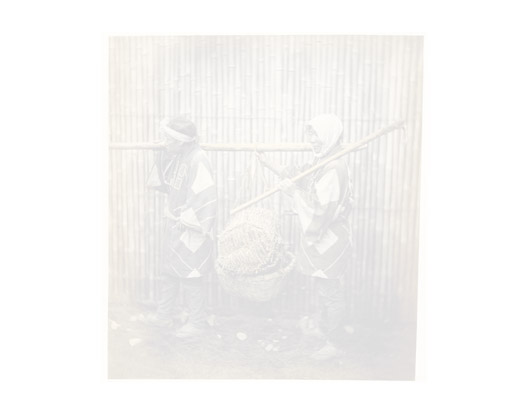
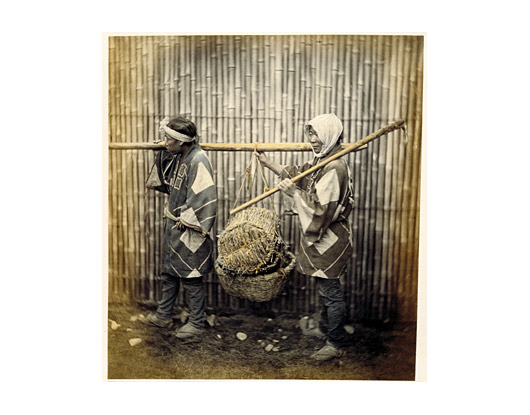
26
COOLIE.
THE veritable coolie is a nondescript sort of individual who does not appear to have any friends—he lives for himself alone, apparently. Never seems to have a house, or a wife, or children. At least, we never see any little coolies!
How he comes into the world is a mystery, how he lives is a wonder, and what becomes of him when he dies nobody seems to care. His whole property and stock in trade consist of a stout bamboo or piece of wood about five feet long, and some straw rope. His clothing he hires; his food he obtains at a street stall. When he earns, by hard work, a few tempoes he either treats himself to an extra meal washed down by a draught of sweet saki, or gambles until all is lost.
”Nin-soku—”the Japanese term for coolie is compounded of two words “nin,” man, and “soku” help; and the class embraces firemen, cart-pushers and porters.
THE veritable coolie is a nondescript sort of individual who does not appear to have any friends—he lives for himself alone, apparently. Never seems to have a house, or a wife, or children. At least, we never see any little coolies!
How he comes into the world is a mystery, how he lives is a wonder, and what becomes of him when he dies nobody seems to care. His whole property and stock in trade consist of a stout bamboo or piece of wood about five feet long, and some straw rope. His clothing he hires; his food he obtains at a street stall. When he earns, by hard work, a few tempoes he either treats himself to an extra meal washed down by a draught of sweet saki, or gambles until all is lost.
”Nin-soku—”the Japanese term for coolie is compounded of two words “nin,” man, and “soku” help; and the class embraces firemen, cart-pushers and porters.
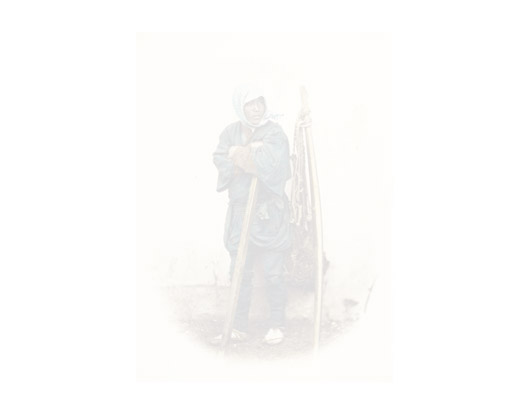
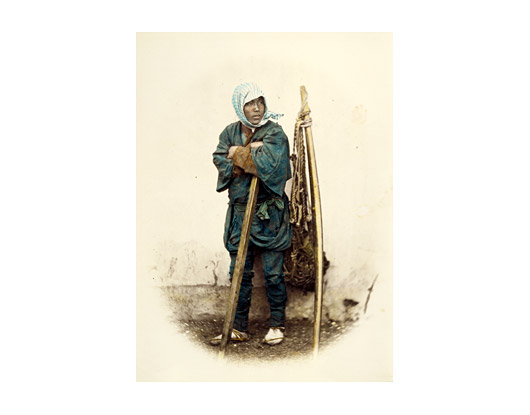
27
BARBERS.
ALL Japanese who are not Priests or Physicians shave their head, from the forehead to the nape of the neck; the hair left about the neck and temples, being well oiled, turned up in a cue and tied with paper points. Most Japanese are shaved daily; and in addition to the head, the face and even the nose is shaved, the ears are bored out, and the eyelids often turned back and scraped; to this cause is principally owing the disease of the eye, as much irritation is caused by this operation.
Latterly the Japanese have fallen into the foreign habit of allowing the hair on the head to grow, and have abandoned in some instances the shaving of the forehead. Beards, however, are not worn, except by doctors, and sometimes priests, with whom it appears optional.
ALL Japanese who are not Priests or Physicians shave their head, from the forehead to the nape of the neck; the hair left about the neck and temples, being well oiled, turned up in a cue and tied with paper points. Most Japanese are shaved daily; and in addition to the head, the face and even the nose is shaved, the ears are bored out, and the eyelids often turned back and scraped; to this cause is principally owing the disease of the eye, as much irritation is caused by this operation.
Latterly the Japanese have fallen into the foreign habit of allowing the hair on the head to grow, and have abandoned in some instances the shaving of the forehead. Beards, however, are not worn, except by doctors, and sometimes priests, with whom it appears optional.


28
”SHARIKI,” OR CART PUSHING COOLIES.
These are a distinct class, and receive a higher rate of wages than other coolies, they are paid in Yokohama frequently as much as a Mexican Dollar per trip, sometimes they are engaged by the job. The carts, which are entirely constructed of wood, even to the azletrees, belong to the Custom House, and are always kept there when not in use during the day, and parked there at night, notwithstanding their rather fragile appearance these carts are capable of bearing extraordinary loads, and three, or sometimes four coolies, may frequently be seen dragging along from ten to fifteen piculs or nearly a ton weight.
While working with these carts, the coolies have a peculiarly unpleasant habit of shouting at every step, in a noisy guttural way, which is offensive to the ear. In summer their clothing is of the scantiest description, consisting merely of a hip cloth; in winter the cold necessitates a more decent style of covering.
These are a distinct class, and receive a higher rate of wages than other coolies, they are paid in Yokohama frequently as much as a Mexican Dollar per trip, sometimes they are engaged by the job. The carts, which are entirely constructed of wood, even to the azletrees, belong to the Custom House, and are always kept there when not in use during the day, and parked there at night, notwithstanding their rather fragile appearance these carts are capable of bearing extraordinary loads, and three, or sometimes four coolies, may frequently be seen dragging along from ten to fifteen piculs or nearly a ton weight.
While working with these carts, the coolies have a peculiarly unpleasant habit of shouting at every step, in a noisy guttural way, which is offensive to the ear. In summer their clothing is of the scantiest description, consisting merely of a hip cloth; in winter the cold necessitates a more decent style of covering.
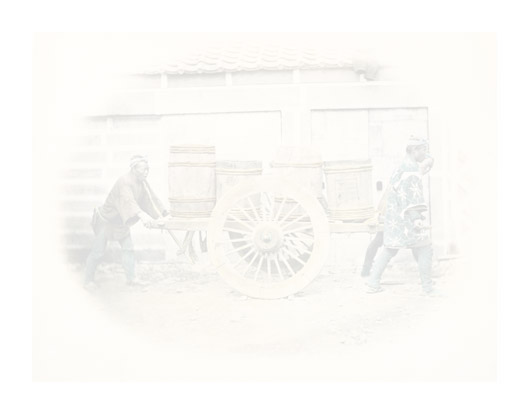
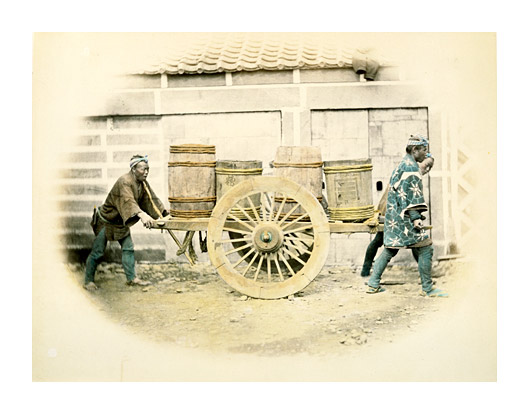
29
BETTOES, OR GROOMS.
IT is believed that the custom of tattooing originated with Sendoes, or Fishermen, who being often employed in the water, imagined that by tattooing their bodies with dragons and other figures, they would frighten away sharks or any sea monsters likely to do them harm. As, however, this beautifying struck the fancy of the bettoes, it was next adopted by them, merely from motives of vanity. A suit of clothing of this sort is expensive, and costs about fifteen rios—or sixty boos. The red tattooing is the most expensive. The operation is gradual; first because it causes considerable irritation and consequent feverishness if any large extent of decoration is done at a sitting; and next, because it is a very tedious operation, taking a long time; and besides, few can afford to pay for more than a small portion of their bodies being done at a time. Bettoes are not the only class, in addition to boatmen and fishermen, who have themselves tattooed. The practice is in vogue amongst kango bearers, and most others whose occupation requires them to be without the ordinary amount of clothing.
IT is believed that the custom of tattooing originated with Sendoes, or Fishermen, who being often employed in the water, imagined that by tattooing their bodies with dragons and other figures, they would frighten away sharks or any sea monsters likely to do them harm. As, however, this beautifying struck the fancy of the bettoes, it was next adopted by them, merely from motives of vanity. A suit of clothing of this sort is expensive, and costs about fifteen rios—or sixty boos. The red tattooing is the most expensive. The operation is gradual; first because it causes considerable irritation and consequent feverishness if any large extent of decoration is done at a sitting; and next, because it is a very tedious operation, taking a long time; and besides, few can afford to pay for more than a small portion of their bodies being done at a time. Bettoes are not the only class, in addition to boatmen and fishermen, who have themselves tattooed. The practice is in vogue amongst kango bearers, and most others whose occupation requires them to be without the ordinary amount of clothing.
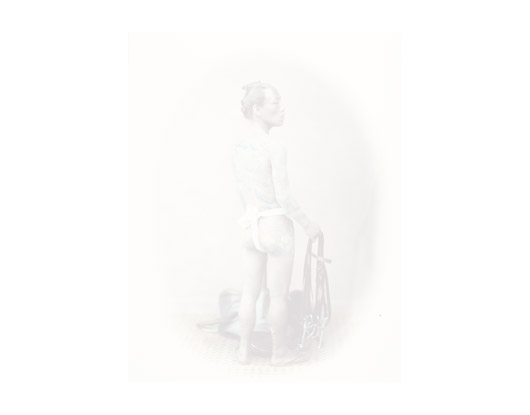
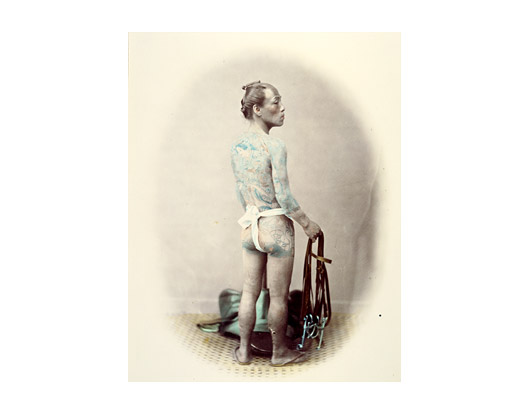
30
SAMURAI OF THE SATSUMA CLAN.
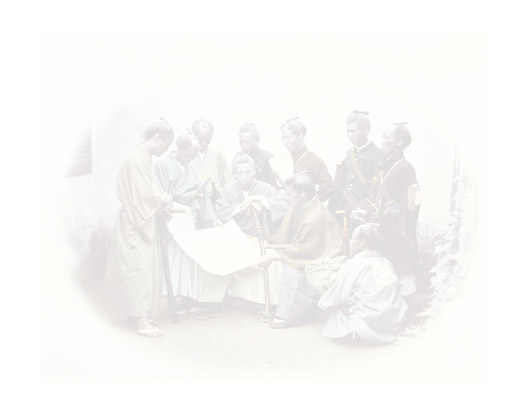
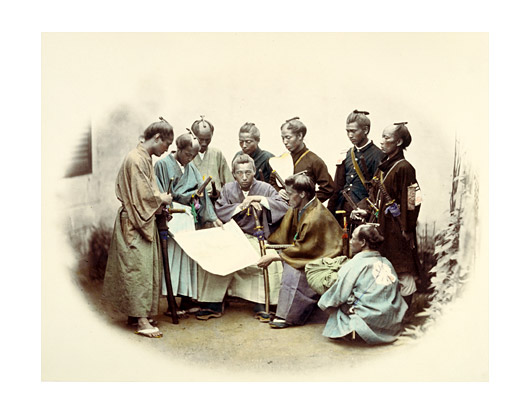
31
JAPANESE YAKONIN IN DRESS OF CEREMONY.
THIS dress is of ancient date and is said to have first been introduced during the reign of Ashi kaji, nearly four hundred years ago. It is worn in all visits of ceremony, especially at the New Year and other holidays, by the Samourai or two sworded class, and also at weddings, feasts, and funerals. It is an extraordinary fact that women in Japan are allowed to exercise their own taste and discretion in the selection of the colours of their costumes—but men are restricted in their choice of colour and of material. Colour is a sign of rank or station among men, and purple is the regal colour, worn by Kuges and some others of the most exalted classes at Miako. Priests may however wear purple, but they are the only permitted exceptions to the law on this subject. As far back as six hundred years ago some Samourai wore when engaged in war, four swords: one at the back, two on the left side, and one on the right side; two of these, however, were laid aside in peaceable times.
THIS dress is of ancient date and is said to have first been introduced during the reign of Ashi kaji, nearly four hundred years ago. It is worn in all visits of ceremony, especially at the New Year and other holidays, by the Samourai or two sworded class, and also at weddings, feasts, and funerals. It is an extraordinary fact that women in Japan are allowed to exercise their own taste and discretion in the selection of the colours of their costumes—but men are restricted in their choice of colour and of material. Colour is a sign of rank or station among men, and purple is the regal colour, worn by Kuges and some others of the most exalted classes at Miako. Priests may however wear purple, but they are the only permitted exceptions to the law on this subject. As far back as six hundred years ago some Samourai wore when engaged in war, four swords: one at the back, two on the left side, and one on the right side; two of these, however, were laid aside in peaceable times.
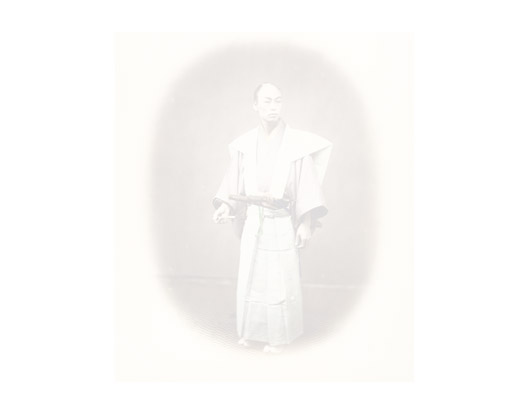
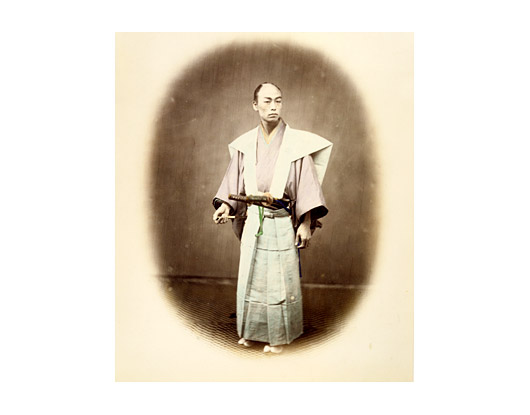
32
SAMOURAI OR TWO SWORDED CLASS.
THE two swords, which are worn as a badge of nobility, or rather as a mark of the classes above the merchant and labourer, are stuck into the belt on the left side, a little crosswise, and with the edge upwards; when the wearer is seated the longer sword is taken from the belt and laid on the ground beside him. The longer swords are broad-backed, slightly curved, about three feet long in the blade and of excellent temper, with a hilt long enough to use with both hands. The shorter sword is straight: the scabbards of both are of wood, sometimes covered with shagreen and lacquered. Siebold thus describes the method of making sword blades:— “The blades, forged out of good bar steel “are plastered over with a paste of potash, porcelain clay and powdered charcoal, and dried in the sun. They “are next exposed to the fire and heated till the mass assumes a white hue. The glowing blades are then “plunged into lukewarm water, three-fifths boiling to two-fifths cold, and cooled gradually, often the edge only is “heated and thus the cooling is with cold water.”
THE two swords, which are worn as a badge of nobility, or rather as a mark of the classes above the merchant and labourer, are stuck into the belt on the left side, a little crosswise, and with the edge upwards; when the wearer is seated the longer sword is taken from the belt and laid on the ground beside him. The longer swords are broad-backed, slightly curved, about three feet long in the blade and of excellent temper, with a hilt long enough to use with both hands. The shorter sword is straight: the scabbards of both are of wood, sometimes covered with shagreen and lacquered. Siebold thus describes the method of making sword blades:— “The blades, forged out of good bar steel “are plastered over with a paste of potash, porcelain clay and powdered charcoal, and dried in the sun. They “are next exposed to the fire and heated till the mass assumes a white hue. The glowing blades are then “plunged into lukewarm water, three-fifths boiling to two-fifths cold, and cooled gradually, often the edge only is “heated and thus the cooling is with cold water.”
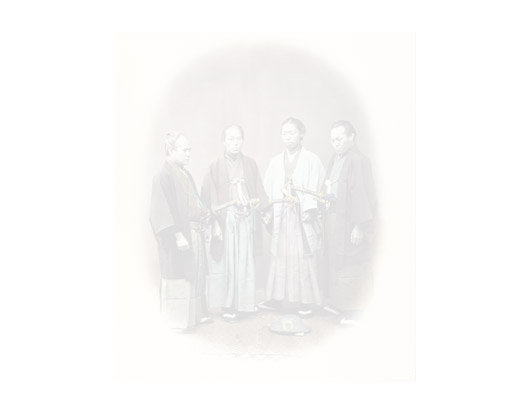
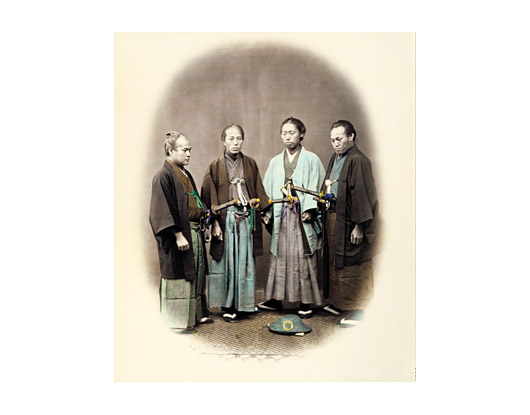
33
YACONIN TRAVELLING ON THE TOKAIDO.
FREQUENTLY an overloaded Packhorse may be seen carrying an additional burthen in the shape of a Yaconin who gets a lift on his road, either for an insignificant sum or perhaps exacts it from the animal’s owner.
The breed of horses in Japan is by no means of superior order, little attention is paid thereto and speed and endurance are qualities neither estimated nor required. The horses used for Daimios or Princes are seldom needed to go beyond a foot pace and those employed by the humbler classes for traveling and carrying burthens or for agricultural purposes are never pushed beyond a walk or an amble. The loads carried by those used as pack animals are wonderfully well balanced and adjusted in the saddles by the drivers, and are sometimes very heavy.
FREQUENTLY an overloaded Packhorse may be seen carrying an additional burthen in the shape of a Yaconin who gets a lift on his road, either for an insignificant sum or perhaps exacts it from the animal’s owner.
The breed of horses in Japan is by no means of superior order, little attention is paid thereto and speed and endurance are qualities neither estimated nor required. The horses used for Daimios or Princes are seldom needed to go beyond a foot pace and those employed by the humbler classes for traveling and carrying burthens or for agricultural purposes are never pushed beyond a walk or an amble. The loads carried by those used as pack animals are wonderfully well balanced and adjusted in the saddles by the drivers, and are sometimes very heavy.
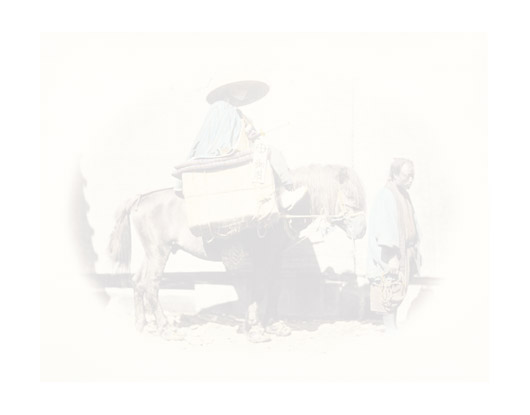
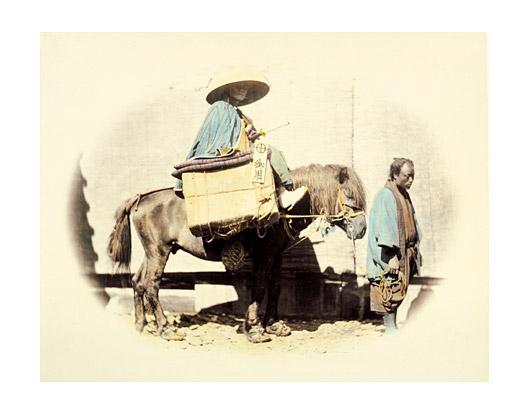
34
STRAW RAIN COAT.
ECONOMICAL as well as useful, these “waterproofs” are not confined to the lower or coolie class. Yakunins and two sworded men may frequently be seen with coats of this description—with the difference that a fine silk netting is spread over the split reeds of which the better ones are made, which prevents them from blowing about and being disarranged by a high wind.
Straw is used for hats and coats and also for shoes, so that in rainy or snowy weather little but straw is seen of a man equipped for traveling.
The same sort of straw coat is to be found in some parts of Portugal.
ECONOMICAL as well as useful, these “waterproofs” are not confined to the lower or coolie class. Yakunins and two sworded men may frequently be seen with coats of this description—with the difference that a fine silk netting is spread over the split reeds of which the better ones are made, which prevents them from blowing about and being disarranged by a high wind.
Straw is used for hats and coats and also for shoes, so that in rainy or snowy weather little but straw is seen of a man equipped for traveling.
The same sort of straw coat is to be found in some parts of Portugal.
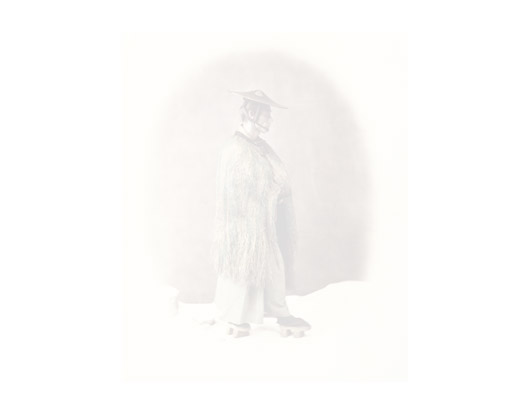
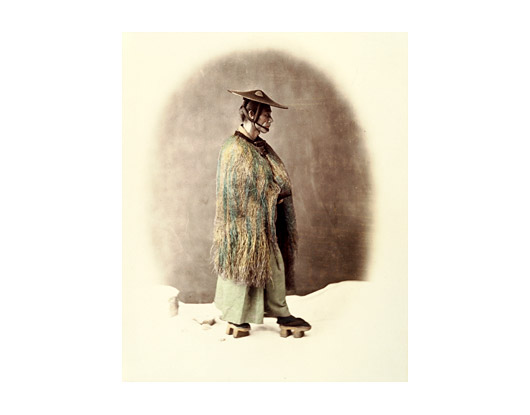
35
KANGO BEARERS.
THESE are superior members of the class of coolies; and are, in fact, distinct from the inferior Ninsoku or street coolies. This in great measure results from the necessity for acquiring experience in carrying the Kango, so that the motion to the passenger may be steady and not uneasy. Kango bearers display extraordinary powers of endurance, and travel at a rate which takes them over as many as thirty miles a day; their pace is an easy slinging trot. In crossing steep mountain passes like that of Hakoni, there are always three bearers to a Kango, and alternate rest is afforded to each in succession; two always carrying, and one running by the side, to take the place of whichever first shows signs of distress.
THESE are superior members of the class of coolies; and are, in fact, distinct from the inferior Ninsoku or street coolies. This in great measure results from the necessity for acquiring experience in carrying the Kango, so that the motion to the passenger may be steady and not uneasy. Kango bearers display extraordinary powers of endurance, and travel at a rate which takes them over as many as thirty miles a day; their pace is an easy slinging trot. In crossing steep mountain passes like that of Hakoni, there are always three bearers to a Kango, and alternate rest is afforded to each in succession; two always carrying, and one running by the side, to take the place of whichever first shows signs of distress.
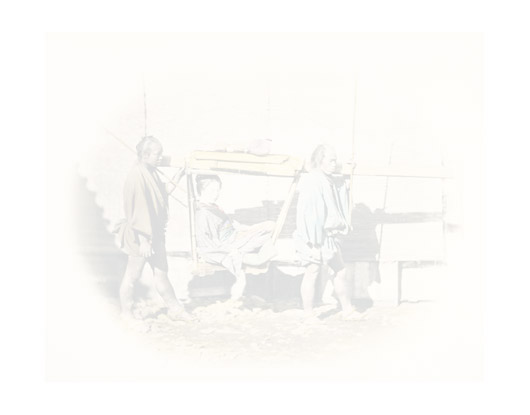
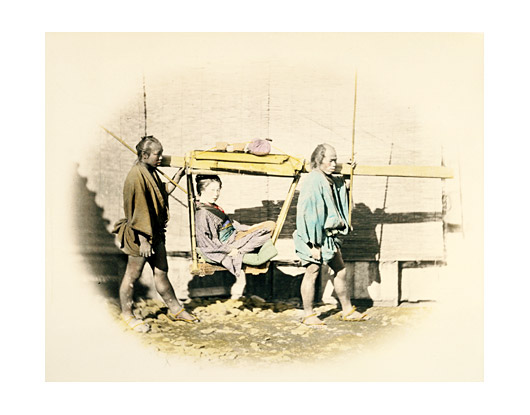
36
NORIMONO, OR SEDAN CHAIR.
THIS is a superior sort of Kango (or Kago). Both sorts rise through such a variety of degrees of quality, that a good Kango is scarce to be distinguished from an inferior Norimono. The pole is the only difference—that of the former being solid, and of the latter being made of four thin boards neatly jointed together, arched, and therefore lighter than it appears. The rank is shown by the length and size of the Norimono’s pole, and as people are apt to get the poles of their Norimonos made larger than their station allows, they are liable to be compelled by the magistrate to reduce them. Women are, however, not affected by this rule, and may use larger poles than their own or their husband’s station permits. … The bearers of the Norimonos of Daimio’s are selected for their symmetry of shape and muscular development, they are also chosen of uniform height, and are trained with as much care as are the favorite thoro’breds of a European Sovereign’s State Carriage.
THIS is a superior sort of Kango (or Kago). Both sorts rise through such a variety of degrees of quality, that a good Kango is scarce to be distinguished from an inferior Norimono. The pole is the only difference—that of the former being solid, and of the latter being made of four thin boards neatly jointed together, arched, and therefore lighter than it appears. The rank is shown by the length and size of the Norimono’s pole, and as people are apt to get the poles of their Norimonos made larger than their station allows, they are liable to be compelled by the magistrate to reduce them. Women are, however, not affected by this rule, and may use larger poles than their own or their husband’s station permits. … The bearers of the Norimonos of Daimio’s are selected for their symmetry of shape and muscular development, they are also chosen of uniform height, and are trained with as much care as are the favorite thoro’breds of a European Sovereign’s State Carriage.
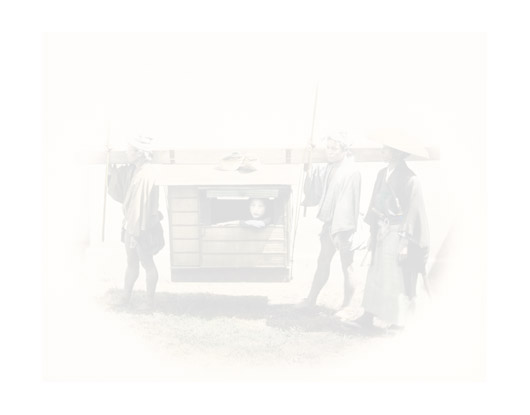
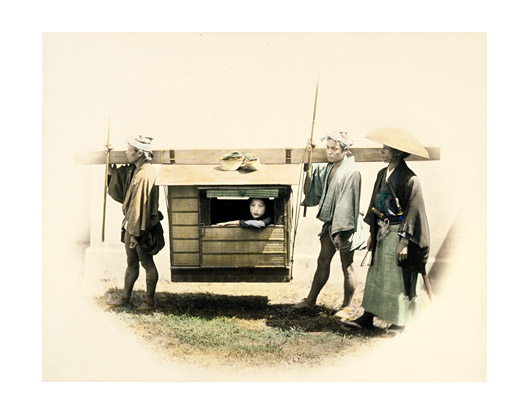
37
ESCORT OFFICER.
THE photograph represents one of the Tycoon’s body guard, selected for their courage and reliability as an escort for foreigners. In Japan, the opposition offered by many of the leading princes to the admission of foreigners, had the effect of creating among the retainers of these daimios a hostile feeling that was always dreaded by the government; and which exhibited itself on several occasions in the murder of individuals, and in attacks upon various legations in Yedo. From the first opening of the ports, therefore, cavalry officers were appointed to escort foreigners not only in Yedo, but in any part of the interior to which they were permitted to go, and in which special precautions were thought to be necessary. …
THE photograph represents one of the Tycoon’s body guard, selected for their courage and reliability as an escort for foreigners. In Japan, the opposition offered by many of the leading princes to the admission of foreigners, had the effect of creating among the retainers of these daimios a hostile feeling that was always dreaded by the government; and which exhibited itself on several occasions in the murder of individuals, and in attacks upon various legations in Yedo. From the first opening of the ports, therefore, cavalry officers were appointed to escort foreigners not only in Yedo, but in any part of the interior to which they were permitted to go, and in which special precautions were thought to be necessary. …
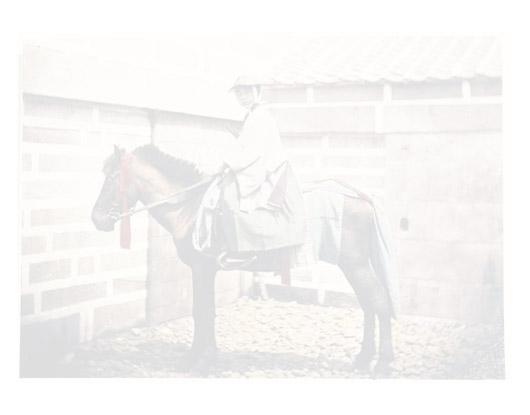
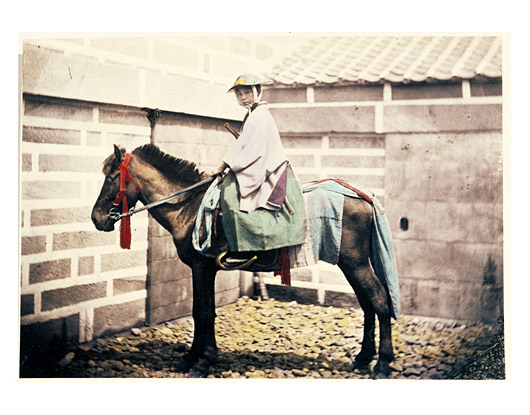
38
YAKONINS IN FIRE DRESS.
What is known as a Fire Coat is one made of Leather beneath which is worn an undershirt or vest, also of the same material. As a protection for the head, a Lacquered hat or helmet with a curtain (sometimes strengthened by plates of metal sewed on) and a front piece to cover the lower part of the face is also worn.
The Yakonin in authority carries a metal baton which is often used freely on the heads of offending coolies. It is said to be part of the duty of Japanese soldiers to assist in extinguishing fires for which purpose they are provided with a fireman’s dress, and it is considered to be a glorious achievement to extinguish a fire.
Almost every house is provided with a large tub for water, and many with a little pyramid of buckets, always kept full as a precaution against fire, and although this is far from being sufficient to stop the fury of a flame which has once joined strength it is often useful in preventing the first spread of a conflagration.
What is known as a Fire Coat is one made of Leather beneath which is worn an undershirt or vest, also of the same material. As a protection for the head, a Lacquered hat or helmet with a curtain (sometimes strengthened by plates of metal sewed on) and a front piece to cover the lower part of the face is also worn.
The Yakonin in authority carries a metal baton which is often used freely on the heads of offending coolies. It is said to be part of the duty of Japanese soldiers to assist in extinguishing fires for which purpose they are provided with a fireman’s dress, and it is considered to be a glorious achievement to extinguish a fire.
Almost every house is provided with a large tub for water, and many with a little pyramid of buckets, always kept full as a precaution against fire, and although this is far from being sufficient to stop the fury of a flame which has once joined strength it is often useful in preventing the first spread of a conflagration.
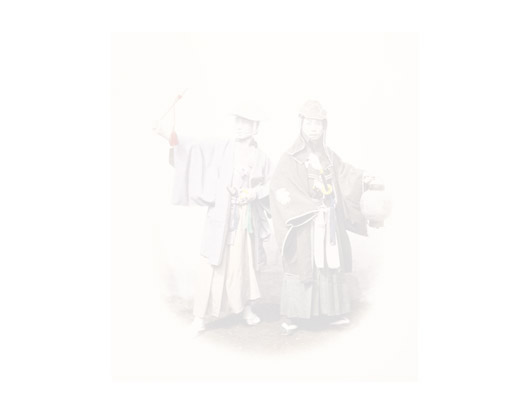
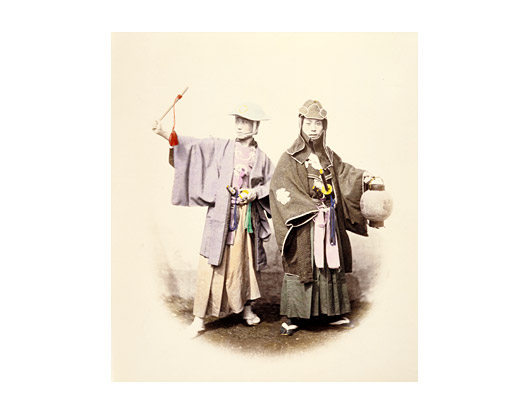
39
MAN AND HORSE WITH BARRELS.
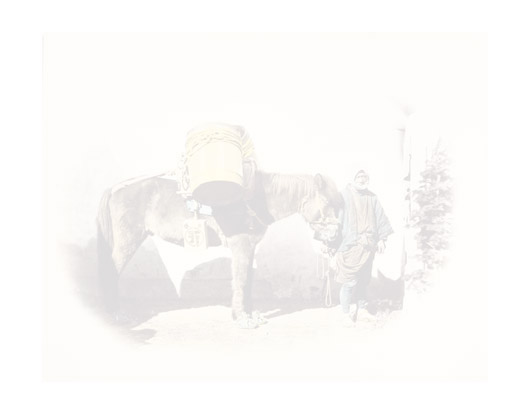
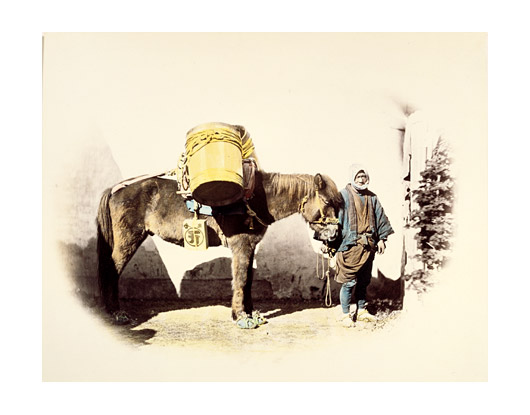
40
SUMOTORI OR WRESTLERS.
2.
THE adversaries, having been announced, step into the ring from the East and the West. They stamp their feet and slap their huge thighs in imitation of the God of strength. The umpire holding his fan of office and dressed in full dress, watches them as they crouch opposite to one another: as soon as he sees them draw breath together he gives the signal for them to spring. Then the two giants close and holding one another in an iron grip try every throw in turn. Of these there are forty eight; and it is the duty of the umpire to see that no other trick is used. The excitement of the spectators knows no bounds. They loudly back the Eastern or Western Champion, and when, at last, the victory has declared itself, they yell with delight, stripping off some article of clothing, and throwing it into the Ring—to be redeemed afterwards in money. None of these pledges are redeemed more liberally than those which have been thrown in by the ladies, who are the special patronesses of the wrestling and the Ring.
2.
THE adversaries, having been announced, step into the ring from the East and the West. They stamp their feet and slap their huge thighs in imitation of the God of strength. The umpire holding his fan of office and dressed in full dress, watches them as they crouch opposite to one another: as soon as he sees them draw breath together he gives the signal for them to spring. Then the two giants close and holding one another in an iron grip try every throw in turn. Of these there are forty eight; and it is the duty of the umpire to see that no other trick is used. The excitement of the spectators knows no bounds. They loudly back the Eastern or Western Champion, and when, at last, the victory has declared itself, they yell with delight, stripping off some article of clothing, and throwing it into the Ring—to be redeemed afterwards in money. None of these pledges are redeemed more liberally than those which have been thrown in by the ladies, who are the special patronesses of the wrestling and the Ring.
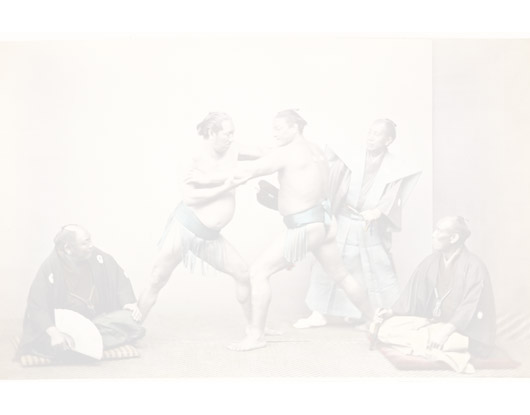
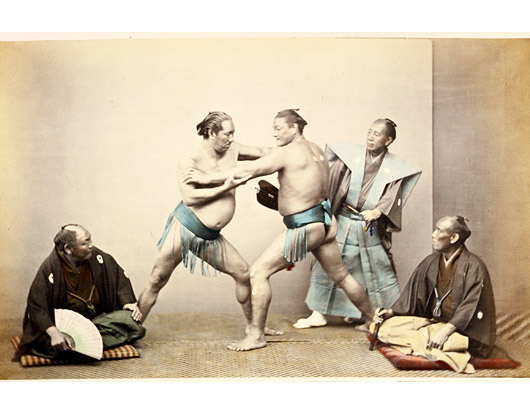
41
FENCERS.
FENCING is a favorite exercise among the yakunins and two-sworded class; and is practiced to give proficiency in the use of the two-handed sword.
Previous to commencing, the performers invariably salute each other with true Japanese ceremony; such as—”Will you do me the favour to teach me the art of fencing?” At the same time they bow with their heads to the ground. After engaging and battering each other with untiring energy, the same ceremony and politeness are repeated, and mutual thanks expressed. In fencing, the head is protected by a strong mask with iron bars over the face, and thick quilted leather curtains down the neck round the ears; the body also, has a cuirass of iron and leather, and the hips a sort of kilt of the same material. Notwithstanding all this armour, severe blows, unless warded, inflict considerable pain, and occasion a loss of temper which sometimes results in fierce hand to hand grappling; in which case, the one who first tears the mask from his adversary, is deemed the victor.
FENCING is a favorite exercise among the yakunins and two-sworded class; and is practiced to give proficiency in the use of the two-handed sword.
Previous to commencing, the performers invariably salute each other with true Japanese ceremony; such as—”Will you do me the favour to teach me the art of fencing?” At the same time they bow with their heads to the ground. After engaging and battering each other with untiring energy, the same ceremony and politeness are repeated, and mutual thanks expressed. In fencing, the head is protected by a strong mask with iron bars over the face, and thick quilted leather curtains down the neck round the ears; the body also, has a cuirass of iron and leather, and the hips a sort of kilt of the same material. Notwithstanding all this armour, severe blows, unless warded, inflict considerable pain, and occasion a loss of temper which sometimes results in fierce hand to hand grappling; in which case, the one who first tears the mask from his adversary, is deemed the victor.
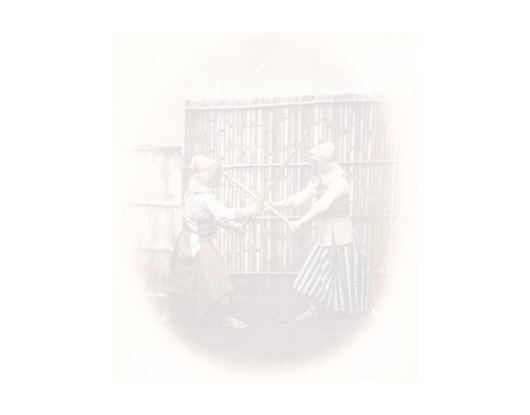
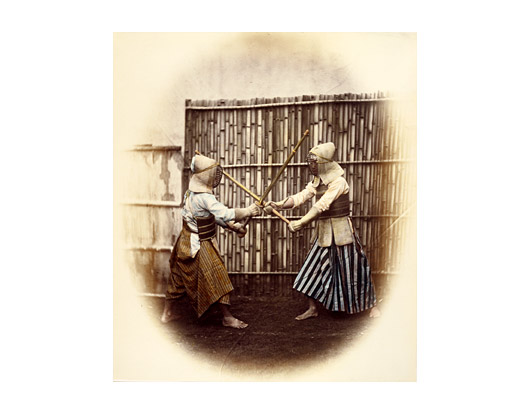
42
CURIO SHOP.
NOTHING attracts a stranger so readily as the sight of a Japanese Curio Shop. The ingenuity and cleverness displayed in the manufacture of the exquisite little articles of ivory carving, cabinets, lacquered-ware, bamboo and straw work, paper, crockery, egg-shell china, &c., are admirable.
The lacquered-ware of Japanese inlaid shell, mosaic with gold tracing, or plain, is of very fine quality,—far superior to that made in China,—is peculiar to the country, and is unequalled. Lacquered wooden dishes, cups, &c., often of elegant design and workmanship, are used for refreshments, —tea, saki, and other hot things. After use they are washed with warm water and wiped dry; and thus the luster is preserved for years. The prices asked for really old lacquer are almost fabulous.
Of ivory carvings there are some of superior workmanship, but expensive. The bamboo work, however, such as cigar cases, &c., and the paper imitations of leather, are cheap; and for their peculiarity well worth purchasing.
NOTHING attracts a stranger so readily as the sight of a Japanese Curio Shop. The ingenuity and cleverness displayed in the manufacture of the exquisite little articles of ivory carving, cabinets, lacquered-ware, bamboo and straw work, paper, crockery, egg-shell china, &c., are admirable.
The lacquered-ware of Japanese inlaid shell, mosaic with gold tracing, or plain, is of very fine quality,—far superior to that made in China,—is peculiar to the country, and is unequalled. Lacquered wooden dishes, cups, &c., often of elegant design and workmanship, are used for refreshments, —tea, saki, and other hot things. After use they are washed with warm water and wiped dry; and thus the luster is preserved for years. The prices asked for really old lacquer are almost fabulous.
Of ivory carvings there are some of superior workmanship, but expensive. The bamboo work, however, such as cigar cases, &c., and the paper imitations of leather, are cheap; and for their peculiarity well worth purchasing.
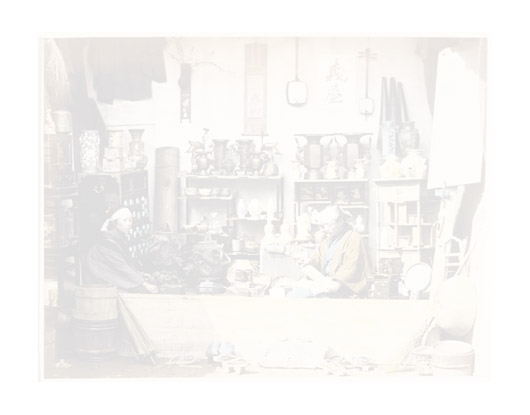
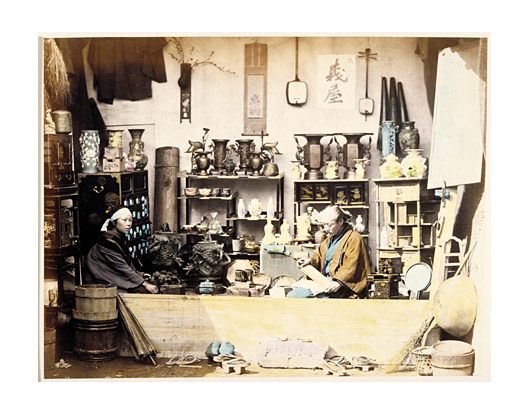
43
PORTRAIT of Mr. Shôjirô, a gentleman in spectacles, who may be safely backed to get the best of it in any bargain to which he may put his hand. With that ingenious little calculating table of his, an instrument used from St. Petersburg to Pekin and Japan, he will finish, in a few seconds, an intricate arithmetical problem, that might puzzle Professor Babbage. From the “soroban” there is no appeal; you may add, divide, subtract and multiply as you please; if your result differs from that of Mr. Shôjirô, he will hold to it that he is right, and, what is more, he will be right.
Humble and unpretending as Mr. Shôjirô may be when he is out on business, in his own house and in private life, he is a great man in his way. He girds on two swords and wears silk and fine linen. The prettiest girls in Yedo tune their “samishens” for his ears; the finest tea from Uji, the driest saké from Osaka are warmed up for his refection. Occasionally he will even be invited to the house of some great Daimio whom he has obliged with a loan of money. …
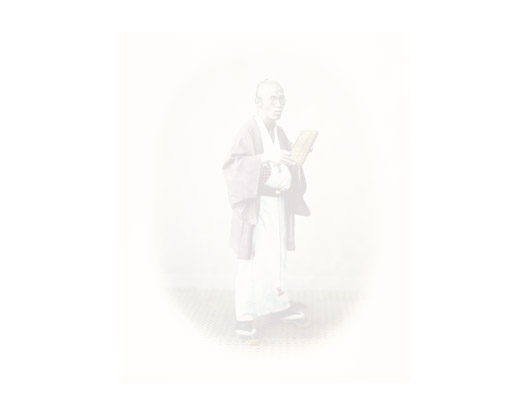
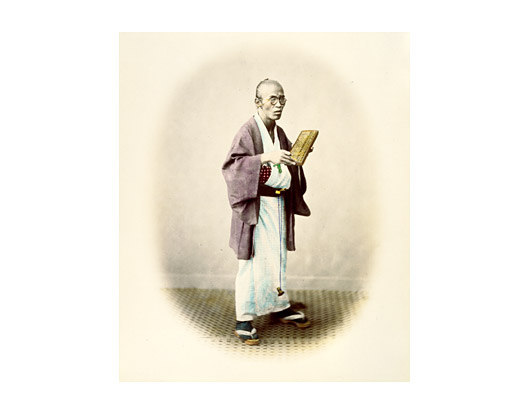
44
OUR PAINTER.
OUR painter in full summer working costume—light, comfortable, cool and inexpensive. A bit of a roué is our painter, much given to wine, and not insensible to the charms of singing girls. A good creature on the whole, but with that tinge of Bohemianism which distinguishes his order all over the world. The painter in Rome, at Paris, or in London, prides himself on being a child of nature, unfettered by the conventionalities of society. He is petted by the rich, and very popular with les petites dames, for he is a good hand at a joke and famous for comic songs and dances.
Some of the Yedo artists live entirely by being invited out to parties where they draw pictures to order; turning out in a few strokes of the brush, a mount Fuji, a warrior in full armour, a dragon and tiger, or a bamboo grove. Sometimes even some little scene of more intimate Japanese life unpresentable to eyes polite.
His stipend is small—but so are his requirements. If he has rice enough for the day he takes no care for the morrow. The amusement of the moment is the business of his life.
OUR painter in full summer working costume—light, comfortable, cool and inexpensive. A bit of a roué is our painter, much given to wine, and not insensible to the charms of singing girls. A good creature on the whole, but with that tinge of Bohemianism which distinguishes his order all over the world. The painter in Rome, at Paris, or in London, prides himself on being a child of nature, unfettered by the conventionalities of society. He is petted by the rich, and very popular with les petites dames, for he is a good hand at a joke and famous for comic songs and dances.
Some of the Yedo artists live entirely by being invited out to parties where they draw pictures to order; turning out in a few strokes of the brush, a mount Fuji, a warrior in full armour, a dragon and tiger, or a bamboo grove. Sometimes even some little scene of more intimate Japanese life unpresentable to eyes polite.
His stipend is small—but so are his requirements. If he has rice enough for the day he takes no care for the morrow. The amusement of the moment is the business of his life.
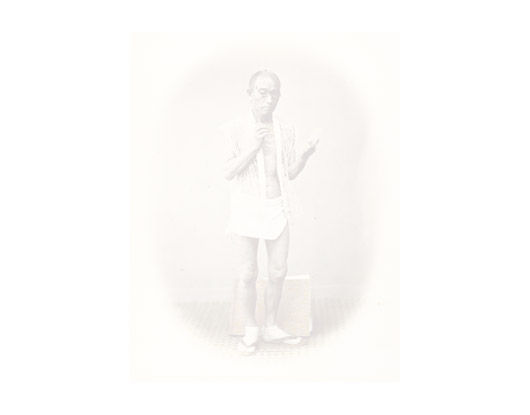
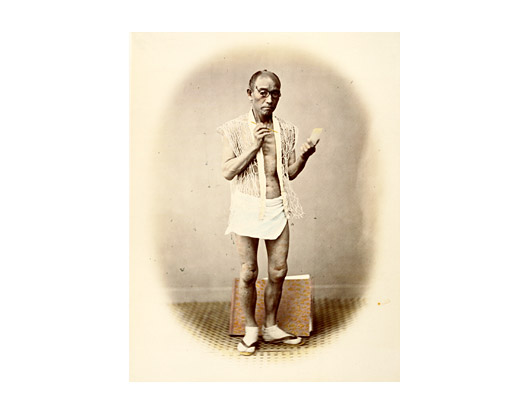
45
THE FORD AT SAKAWA-NAGAWA.
A more extraordinary mode of locomotion cannot well be conceived than the one depicted in the adjoining photograph. The traveller seats himself cross legged on a sort of hand-barrow and is carried on the shoulders of four or six muscular porters. Should the river be rapid a peculiar, sensation of giddiness is often experienced, caused by the speed with which the water races past the bearers and surges sometimes breast high, against their bodies, as they slowly and cautiously advance. Frequently, especially when heavy rain has fallen, or sudden thaw has dissolved the snow among the neighbouring mountains, this river spreads itself over a broad space of the level ground through which the Tokaido leads at this spot, and becomes impassable. As however the porters are held responsible for the lives and property entrusted to their care, they may be relied on never to undertake the passage of the ford unless confident of its practicability. …
A more extraordinary mode of locomotion cannot well be conceived than the one depicted in the adjoining photograph. The traveller seats himself cross legged on a sort of hand-barrow and is carried on the shoulders of four or six muscular porters. Should the river be rapid a peculiar, sensation of giddiness is often experienced, caused by the speed with which the water races past the bearers and surges sometimes breast high, against their bodies, as they slowly and cautiously advance. Frequently, especially when heavy rain has fallen, or sudden thaw has dissolved the snow among the neighbouring mountains, this river spreads itself over a broad space of the level ground through which the Tokaido leads at this spot, and becomes impassable. As however the porters are held responsible for the lives and property entrusted to their care, they may be relied on never to undertake the passage of the ford unless confident of its practicability. …
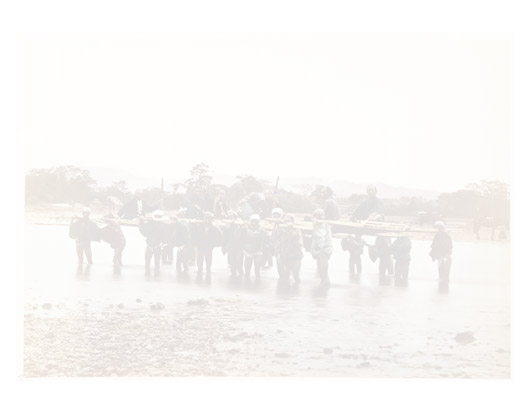
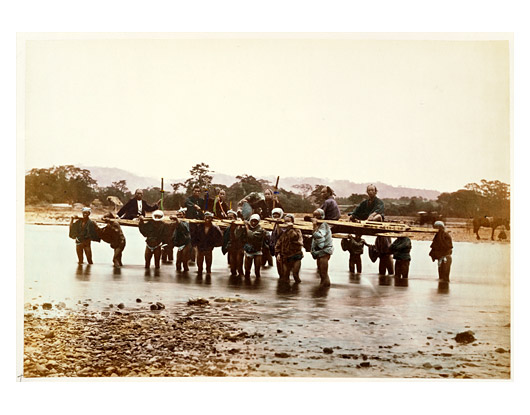
46
SENDOES.
AS a matter of course, the stranger arriving in Japan by sea, the first natives he casts his eyes on are boatmen, or sendoes. Sturdy, well-knit fellows they are; and their limbs, generally uncovered, except in winter or when they yield to the prejudices of foreigners, display an amount of muscular development, calculated to produce a highly favourable impression on admirers of masculine anatomy.
Their bodies are frequently curiously tattooed; not in the savage and hideous manner of South Sea Islanders, but in pictures, oftentimes grotesque enough, but always well drawn and nicely coloured.
The method of propelling their boats is on the principle of sculling; but instead of working the oar in a groove cut for it, as with us, the groove is cut in the oar, and it is worked on a pivot fixed on a kind of outrigger at the side of the boat near the stern. The large, heavy oar is made in the shape shewn in the photograph, and twelve oarsmen in a large boat, will drive her along almost as fast as an ordinary steamer.
AS a matter of course, the stranger arriving in Japan by sea, the first natives he casts his eyes on are boatmen, or sendoes. Sturdy, well-knit fellows they are; and their limbs, generally uncovered, except in winter or when they yield to the prejudices of foreigners, display an amount of muscular development, calculated to produce a highly favourable impression on admirers of masculine anatomy.
Their bodies are frequently curiously tattooed; not in the savage and hideous manner of South Sea Islanders, but in pictures, oftentimes grotesque enough, but always well drawn and nicely coloured.
The method of propelling their boats is on the principle of sculling; but instead of working the oar in a groove cut for it, as with us, the groove is cut in the oar, and it is worked on a pivot fixed on a kind of outrigger at the side of the boat near the stern. The large, heavy oar is made in the shape shewn in the photograph, and twelve oarsmen in a large boat, will drive her along almost as fast as an ordinary steamer.
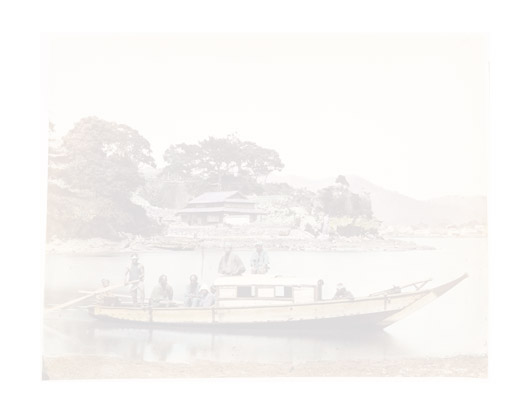
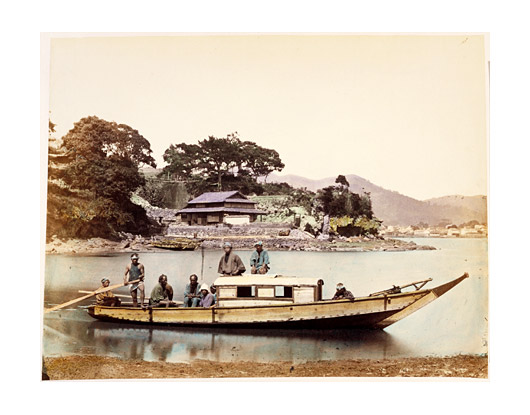
47
A GROUP OF AINOS.
THE Ainos are a people inhabiting the Northern island of Yesso. They differ from the Japanese in language and race. Their origin is lost in a wild and fabulous tradition. The legend runs thus—“That the race owes its preservation to a doll which swam across from Corea to the uninhabited island of Yesso.” They were conquered some three hundred years ago by the Japanese. The people are employed during the summer months in felling trees in the forests, or collecting Kombo (a species of sea-weed) for the Government, and they may be said to be veritable hewers of wood and drawers of water. They are superstitious and have great belief in the supernatural. Their women are stout and handsome, though their beauty is somewhat marred by the habit of tattooing their upper lip.
THE Ainos are a people inhabiting the Northern island of Yesso. They differ from the Japanese in language and race. Their origin is lost in a wild and fabulous tradition. The legend runs thus—“That the race owes its preservation to a doll which swam across from Corea to the uninhabited island of Yesso.” They were conquered some three hundred years ago by the Japanese. The people are employed during the summer months in felling trees in the forests, or collecting Kombo (a species of sea-weed) for the Government, and they may be said to be veritable hewers of wood and drawers of water. They are superstitious and have great belief in the supernatural. Their women are stout and handsome, though their beauty is somewhat marred by the habit of tattooing their upper lip.
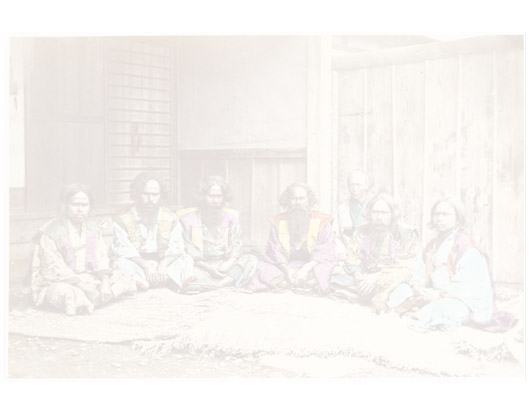
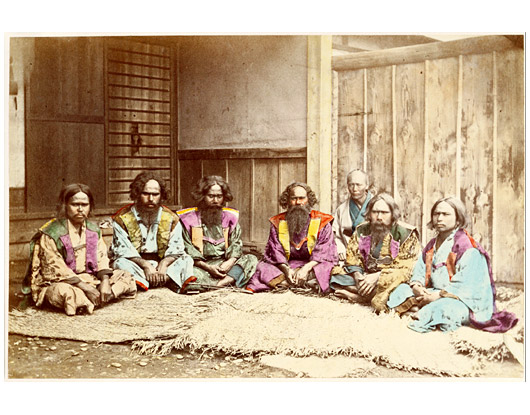
48
THE EXECUTIONER.
DECAPITATION by means of a sword is the most common form of capital punishment in Japan. The criminal is made to kneel on a little mat placed in front of a small rectangular pit, about 2 or 3 feet deep, dug in the ground. He is usually blindfolded, and is made to stretch his head, with his neck uncovered, over the pit. On the signal being given, the executioner whisks off the wretched man’s head at one blow. …
The view represents the execution ground, about a couple of miles from Yokohama, where the murderer of Major Baldwin and Lieut. Bird,—the notorious Shimidzu Seiji—was executed in December 1864. The executioner is a well known old practitioner, who, by his own account, has in a year when business is brisk, a very tolerable income. He receives some 7 ichiboos (about $2.30) per head, and has taken off as many as 350 heads in a twelvemonth. His office, however, is a despised one.
DECAPITATION by means of a sword is the most common form of capital punishment in Japan. The criminal is made to kneel on a little mat placed in front of a small rectangular pit, about 2 or 3 feet deep, dug in the ground. He is usually blindfolded, and is made to stretch his head, with his neck uncovered, over the pit. On the signal being given, the executioner whisks off the wretched man’s head at one blow. …
The view represents the execution ground, about a couple of miles from Yokohama, where the murderer of Major Baldwin and Lieut. Bird,—the notorious Shimidzu Seiji—was executed in December 1864. The executioner is a well known old practitioner, who, by his own account, has in a year when business is brisk, a very tolerable income. He receives some 7 ichiboos (about $2.30) per head, and has taken off as many as 350 heads in a twelvemonth. His office, however, is a despised one.
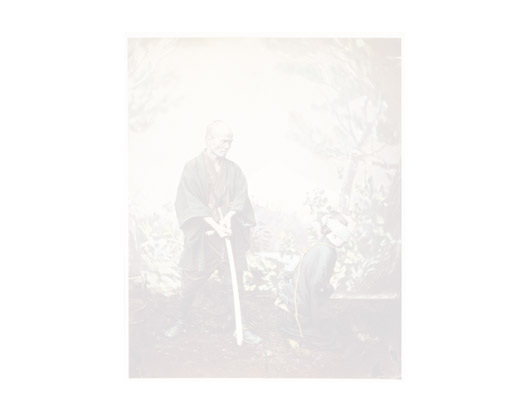
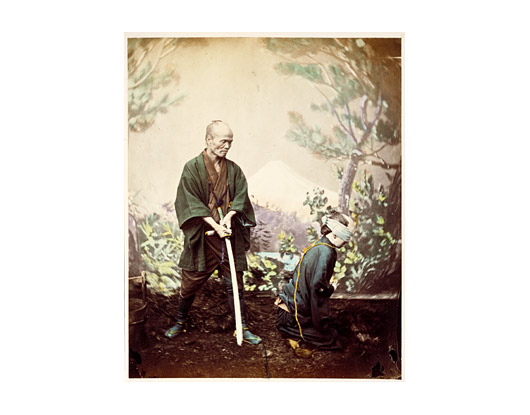
49
EXECUTION.
THERE are several forms of Capital punishment in Japan. The most lenient of these is simple decapitation; the next in order of severity is decapitation with the disgraceful exposure of the head after death; then comes crucifixion, the punishment awarded to those guilty of such crimes as come under the head of parricide; and finally, the burning alive of incendiaries.
Two of these punishments,—crucifixion and the exposure of the head,—are illustrated in the picture.
The victim to be crucified is tied hand and foot to a stout pillar with two horizontal bars across it, and transfixed with spears by persons belonging to the Eta or pariah class, a group of whom are seen sitting in the hut on the right of the picture, watching the remains which it will be their next duty to inter. …
THERE are several forms of Capital punishment in Japan. The most lenient of these is simple decapitation; the next in order of severity is decapitation with the disgraceful exposure of the head after death; then comes crucifixion, the punishment awarded to those guilty of such crimes as come under the head of parricide; and finally, the burning alive of incendiaries.
Two of these punishments,—crucifixion and the exposure of the head,—are illustrated in the picture.
The victim to be crucified is tied hand and foot to a stout pillar with two horizontal bars across it, and transfixed with spears by persons belonging to the Eta or pariah class, a group of whom are seen sitting in the hut on the right of the picture, watching the remains which it will be their next duty to inter. …
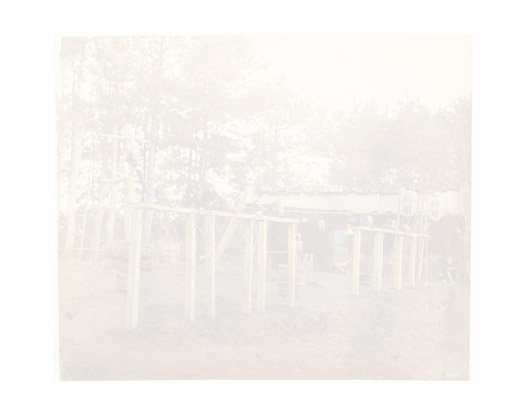
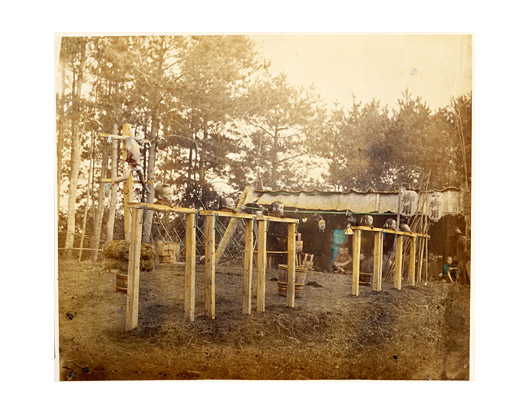
50


